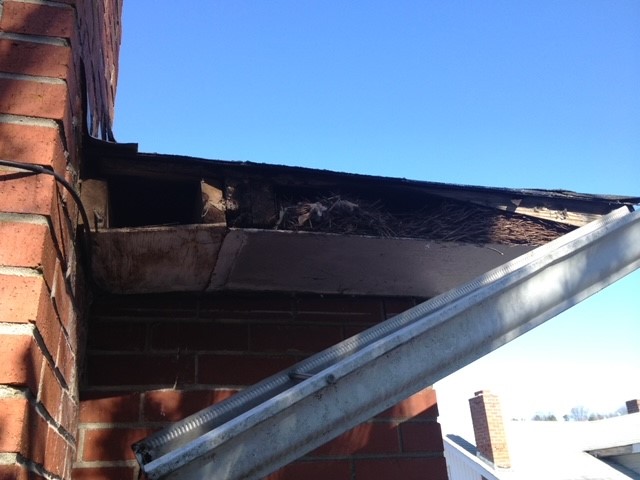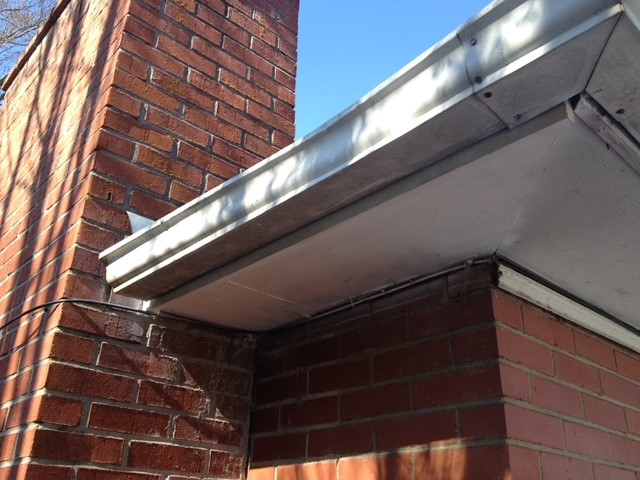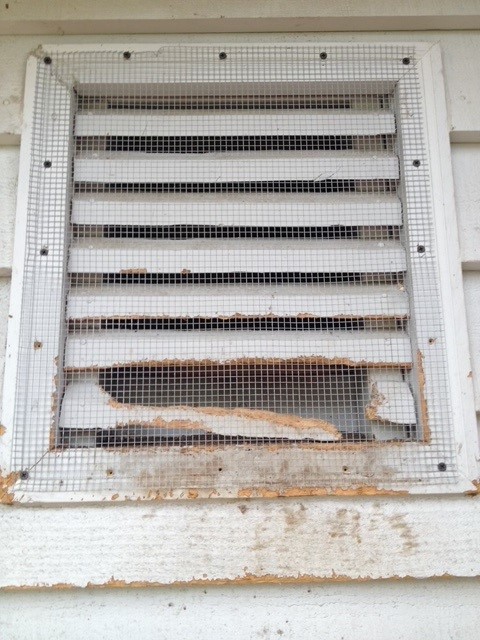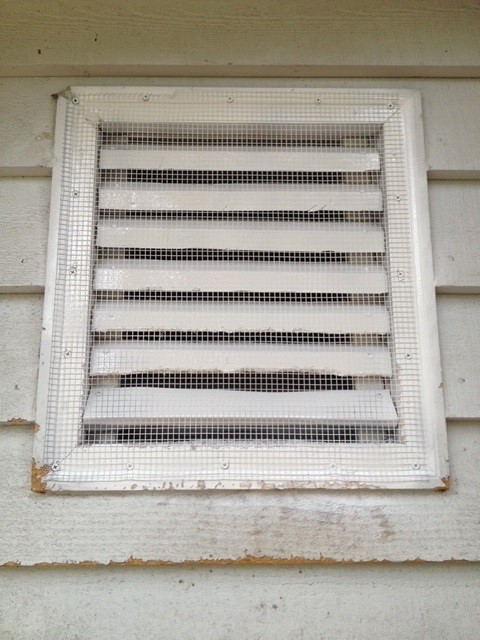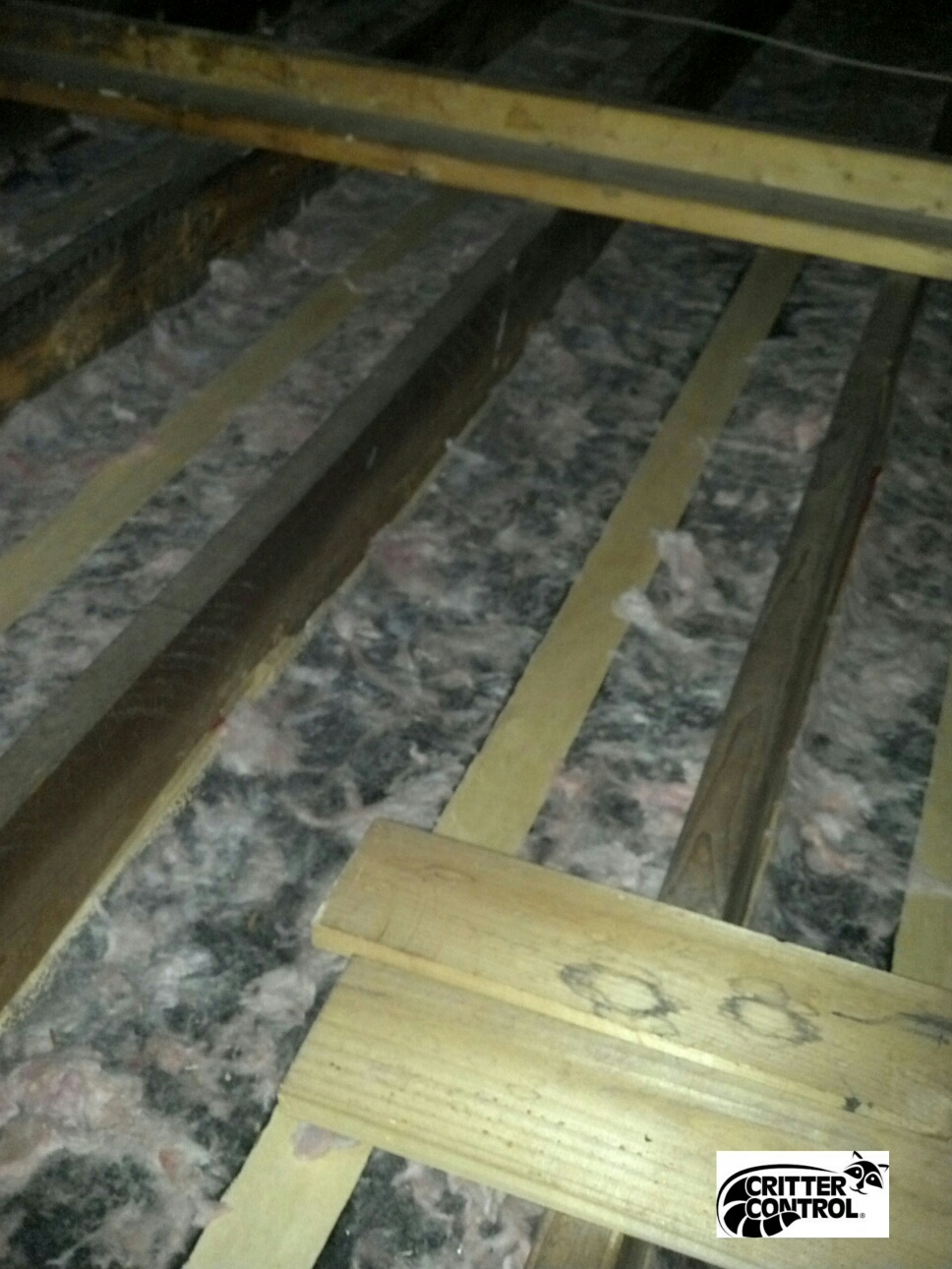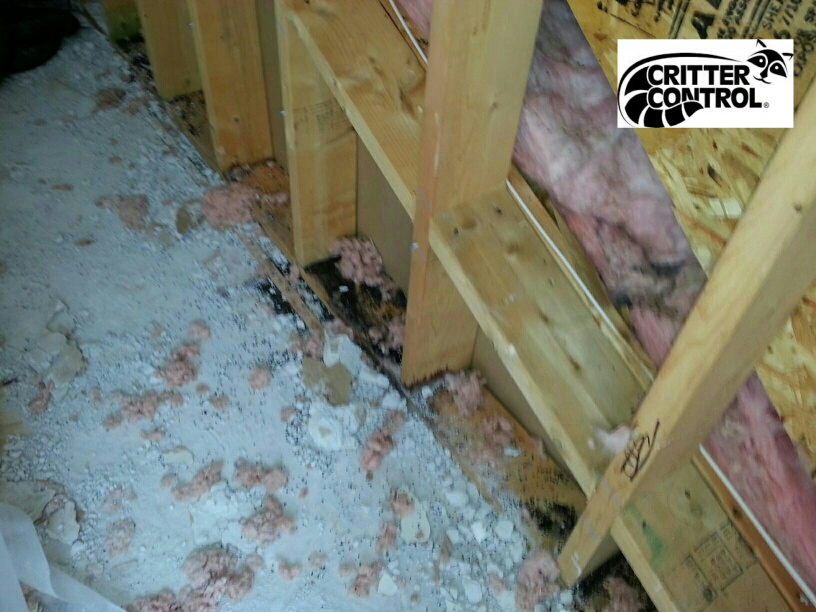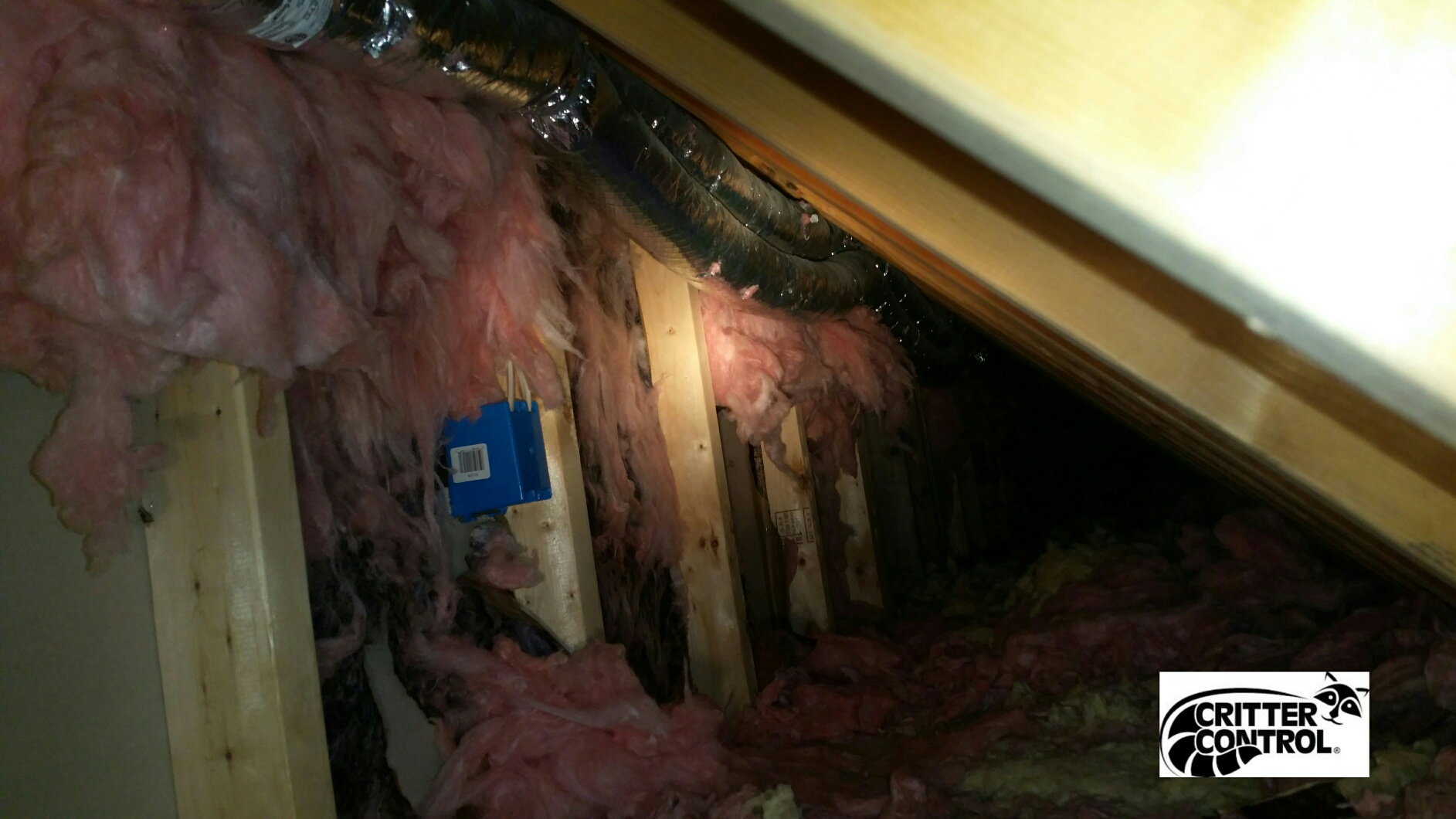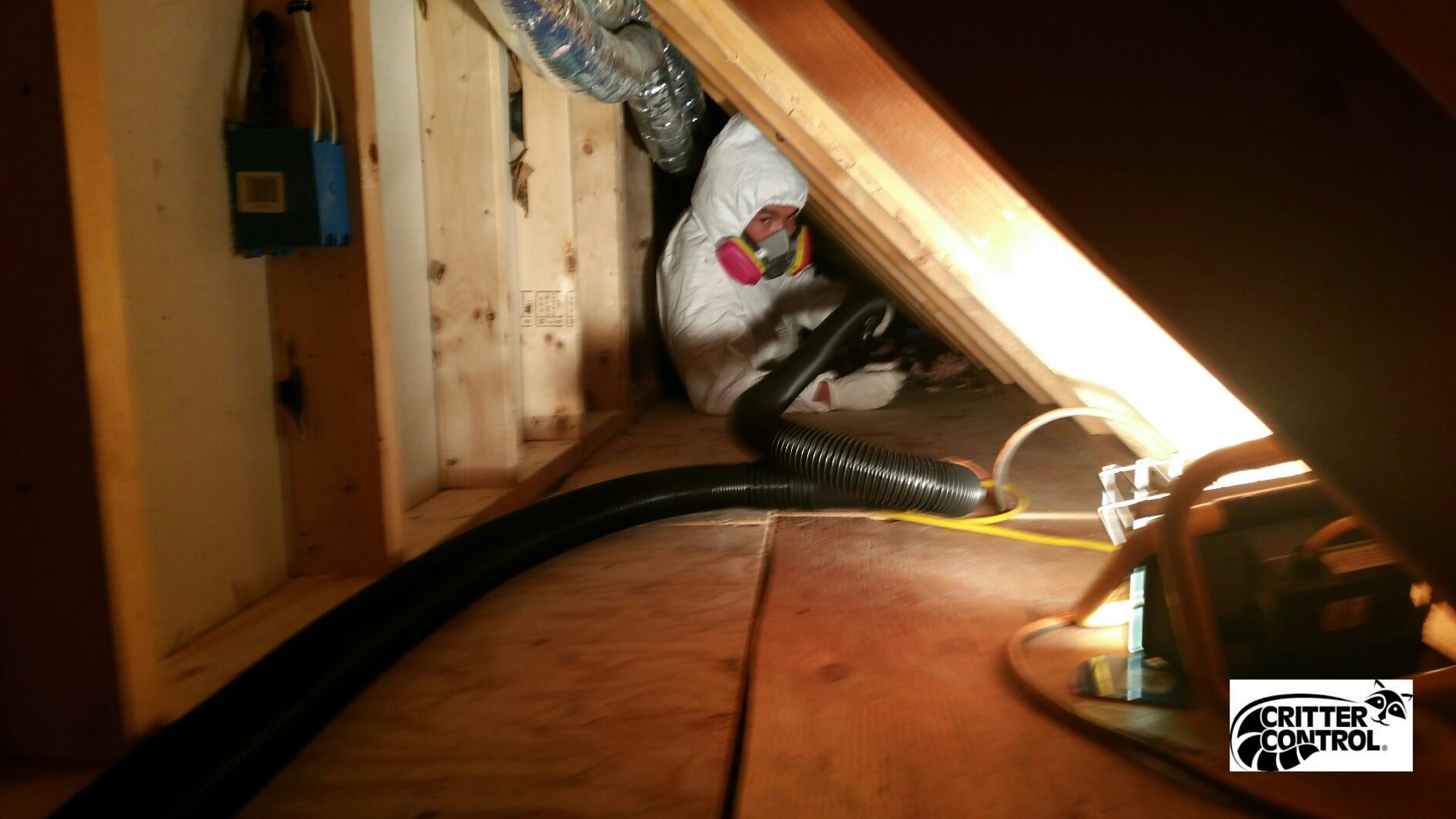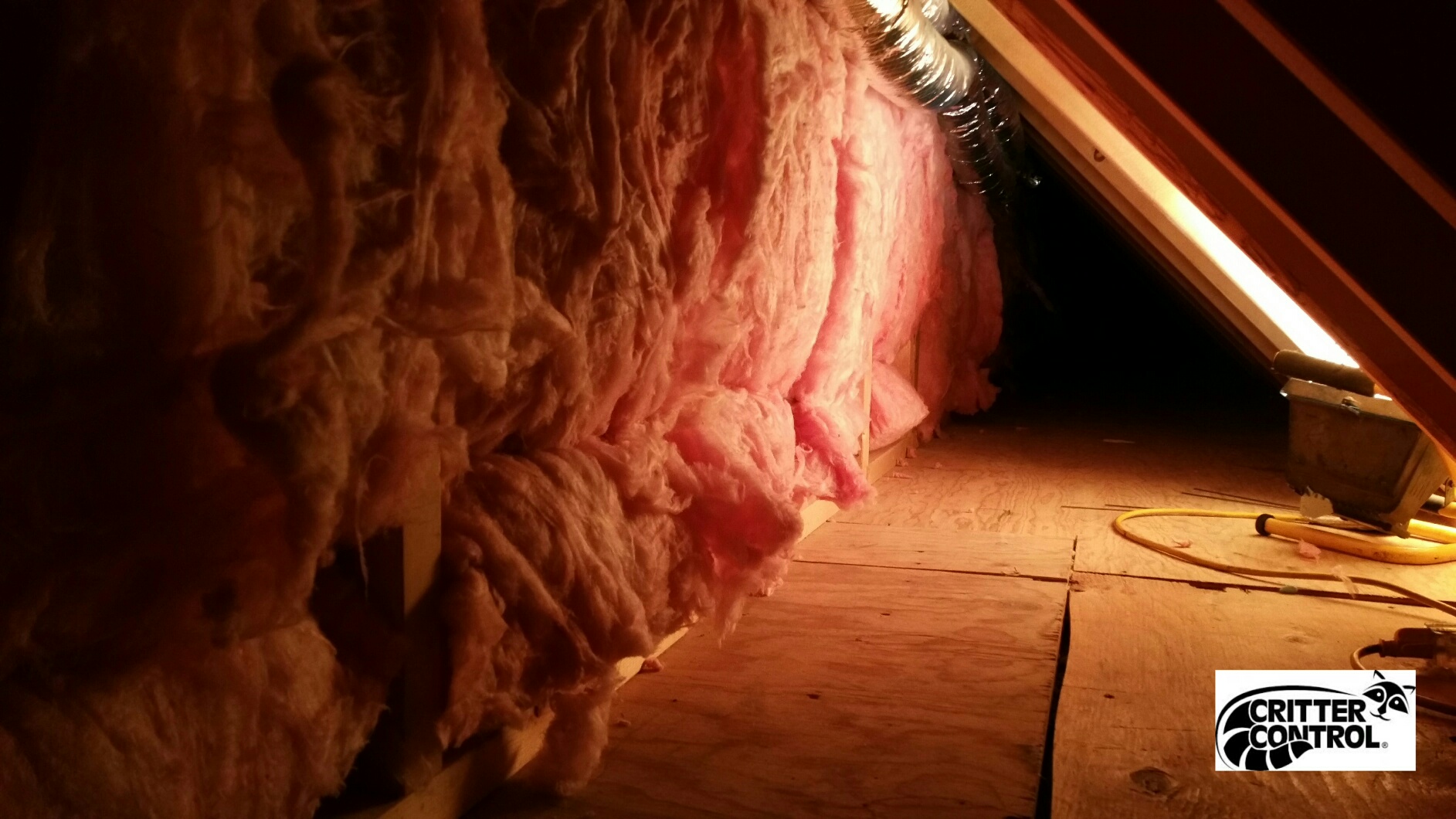Attics are large, unfinished spaces at the top of the house under the roof. The attic serves as a versatile space that contributes to the functionality, comfort, and efficiency of the home. Attics help with temperature regulation by providing insulation and ventilation. The unfinished space can hide bulky equipment like HVAC units and offers a space for storage.
Homeowners don’t spend much time in these hot and humid spaces, but those conditions make it ideal nesting spots for critters. Animals like raccoons, squirrels, and bats find their way into attics, looking for safe places to create dens and nests. You will rarely see the animal in your attic, but you will notice it. It can be hard to ignore an animal in your attic.
Animals in Attic Signs
Noises in the Attic
The first sign you’ll likely encounter is any noises coming from the attic. Noise will alert you that animals are in the attic.
The time of day can help you narrow down the list of suspects. For example, raccoons are nocturnal, which means you’ll primarily hear their noises at night. But squirrels might create noise throughout the day when popping in and out to store food.
Additionally, the type of noise is a useful clue. If you hear chirping, then it’s likely birds in your attic. But if you hear tiny feet scampering, you might have small rodents on your hands.
Animal Waste
After you hear noises, you may want to pop your head into the attic to confirm the presence of a critter. Although you might not see the animal itself, you’ll likely find some evidence of its presence.
Specifically, look for feces, guano, and animal waste. At the very least, animal feces will confirm that you have a critter problem. But if you can identify the droppings, then you can identify the animal species.
Strange Smells
One of the most common smells associated with animals in the attic is the odor of urine. Different animals have distinct urine smells, but generally, they can be quite strong and pungent. Animal droppings can emit a foul smell that worsens over time as they accumulate. The smell can range from musty to downright putrid, depending on the type of animal and the state of decomposition.
In addition to animal droppings, animals in the attic can cause a variety of smells, depending on factors such as the type of animal, its waste, and the duration of its presence. Here are some common odors associated with animals in the attic:
- Nesting Materials: Animals often bring in nesting materials like leaves, twigs, and other debris. Over time, these materials can decay and emit musty or moldy odors, especially if they become damp.
- Body Oils and Grease: Some animals, such as rodents, leave behind body oils and grease as they move around. These oils can accumulate on surfaces and emit a distinctive, unpleasant smell.
- Mold and Mildew: Animal activity in the attic can lead to increased moisture levels, which in turn can promote the growth of mold and mildew. These fungi emit musty odors that can be a sign of a larger problem with moisture and ventilation.
- Food Odors: Animals may bring food into the attic to eat or store for later. Over time, this can lead to the growth of bacteria and the emission of unpleasant food odors.
- Decomposition: If an animal dies in the attic, As the body first begins to decompose, the smell may be localized and not as strong, but after a couple of days, it will become overpowering. The smell of decomposition can quickly become overpowering. It’s a sickly-sweet odor that is hard to ignore and indicates a more serious problem that needs immediate attention.
Rub Marks
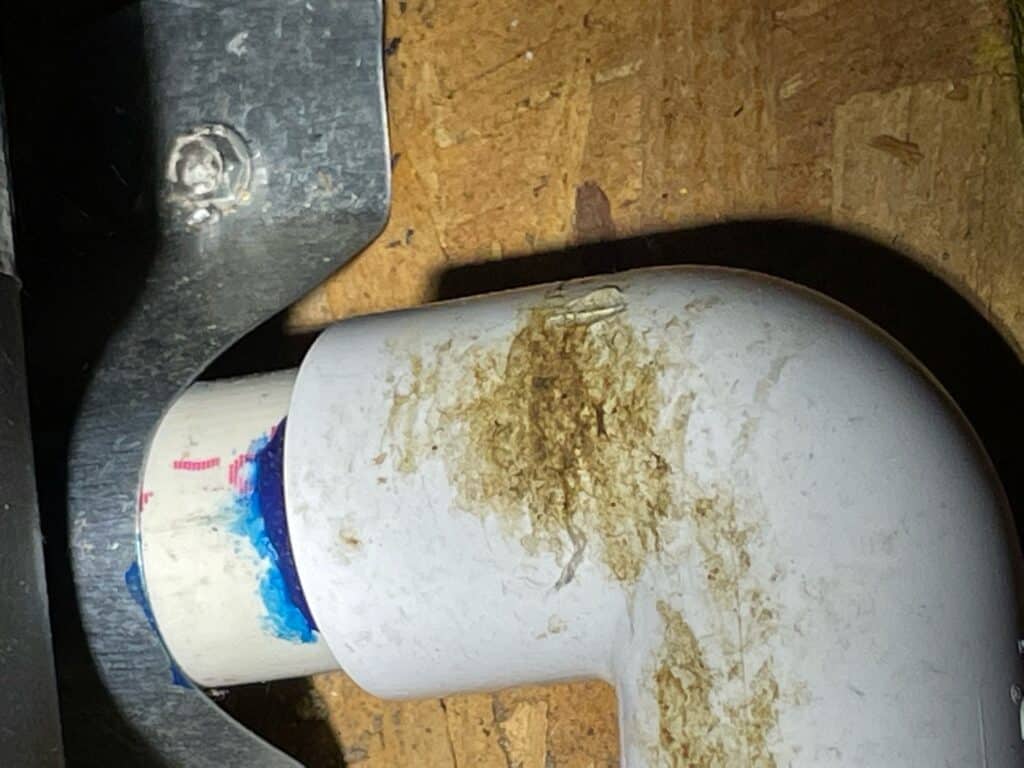
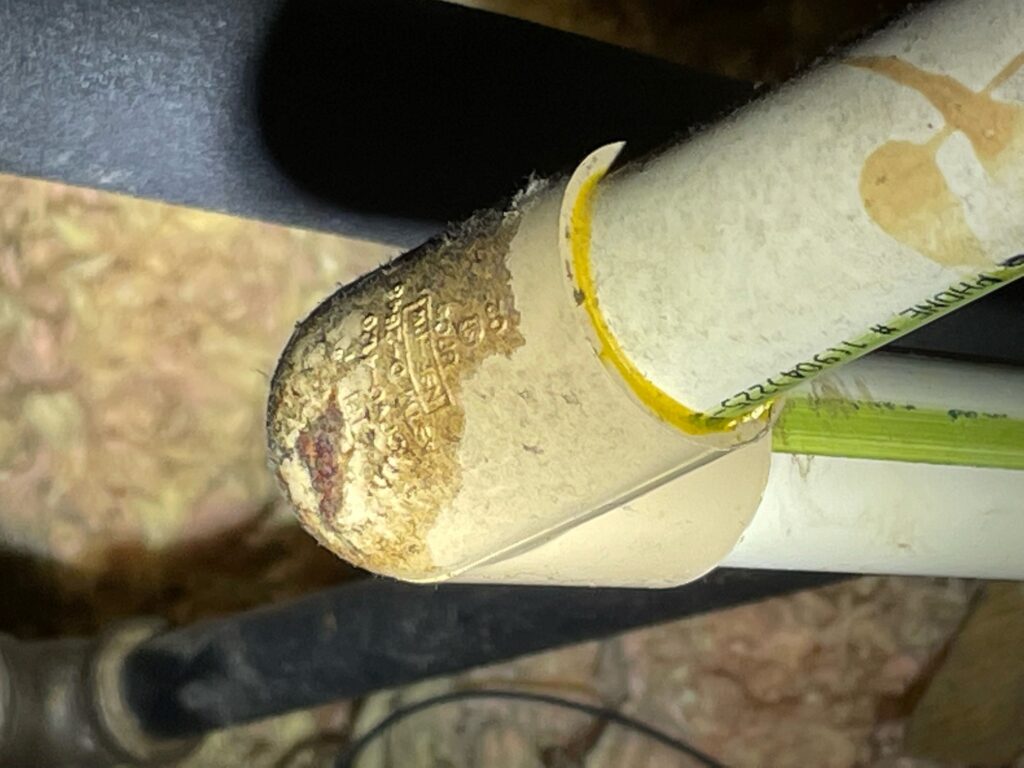
Nuisance wildlife often leave rub marks as they move around your home. These marks typically appear as dark smudges or streaks on exterior surfaces such as walls, siding, and trim. The rub marks are caused by the natural oils and dirt on the animal’s fur transferring onto the surfaces as they repeatedly rub or brush against them.
Common locations for rub marks include entry points, such as gaps around doors and windows, as well as along travel routes and near nesting sites. These marks can vary in size and intensity depending on the type and size of the animal, with larger animals like raccoons and squirrels leaving more noticeable marks.
Identifying rub marks on your house can serve as an indication of wildlife activity and potential entry points, prompting homeowners to take action to prevent further damage and intrusion.
Animal Tracks or Runs
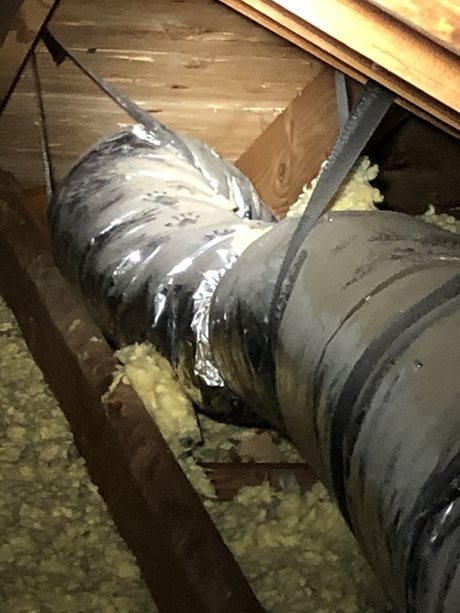
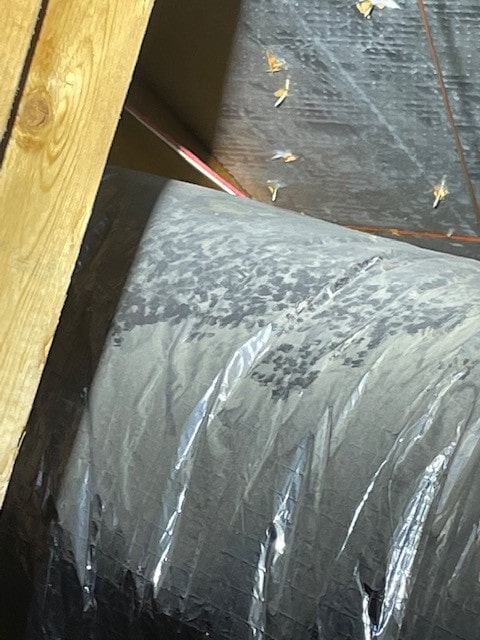
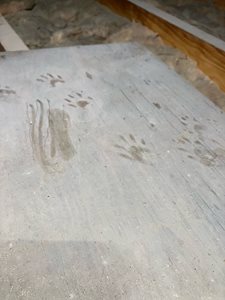
Animals in the attic will leave behind evidence of their movement.
Another indicator that animals will leave behind is paw prints on your ductwork. Opossums and raccoons have the biggest prints. They each have five fingers, but the palm of an opossum’s print is more triangular. Squirrels and rats have much smaller prints with their front feet having four toes and their hind feet having five.
When dealing with mice, rats, and even flying squirrels, you might see tunneling in an attic’s insulation. Typical tunnels are about three inches in diameter.
Animal Damage
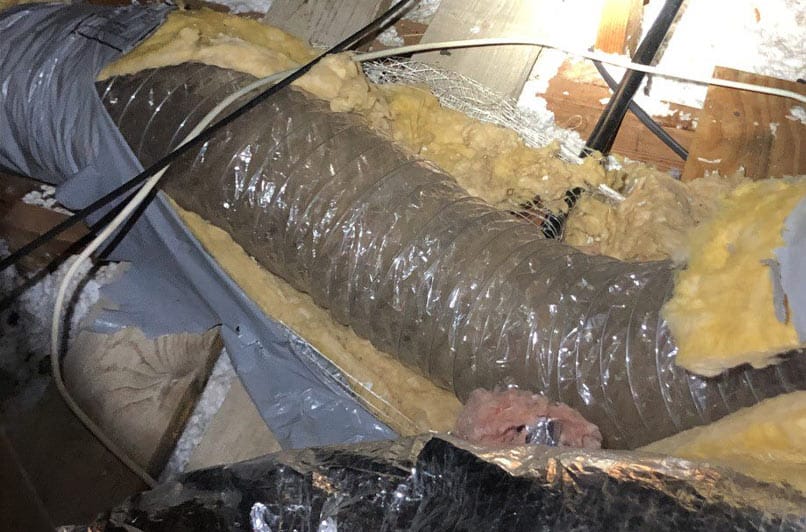
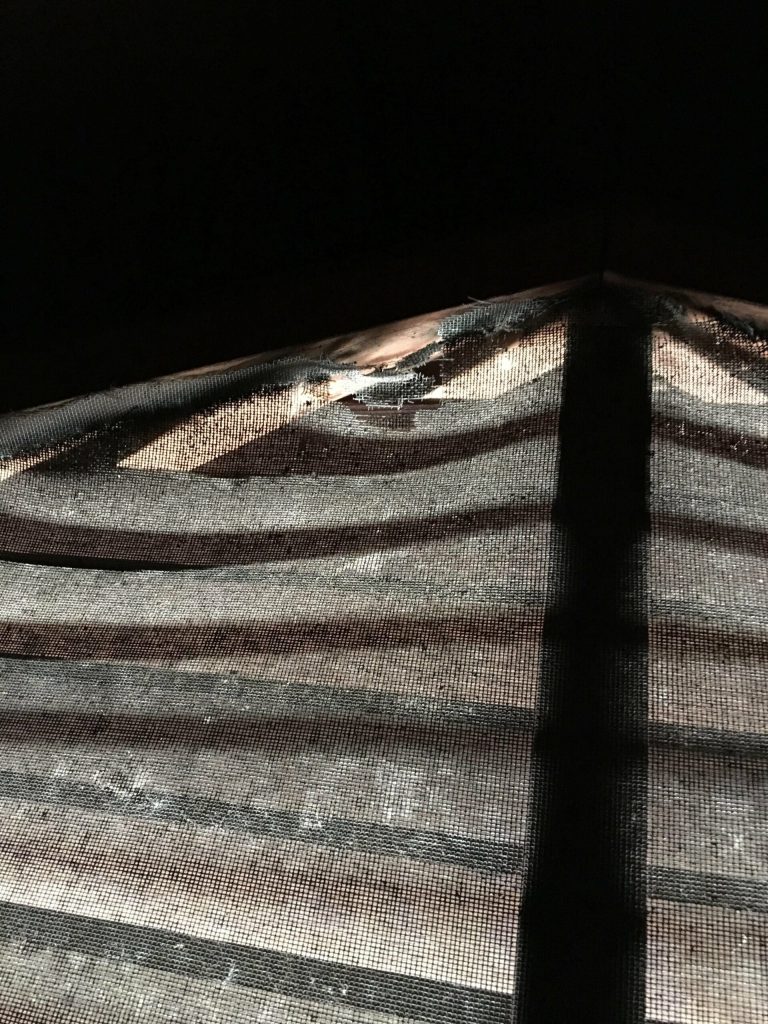
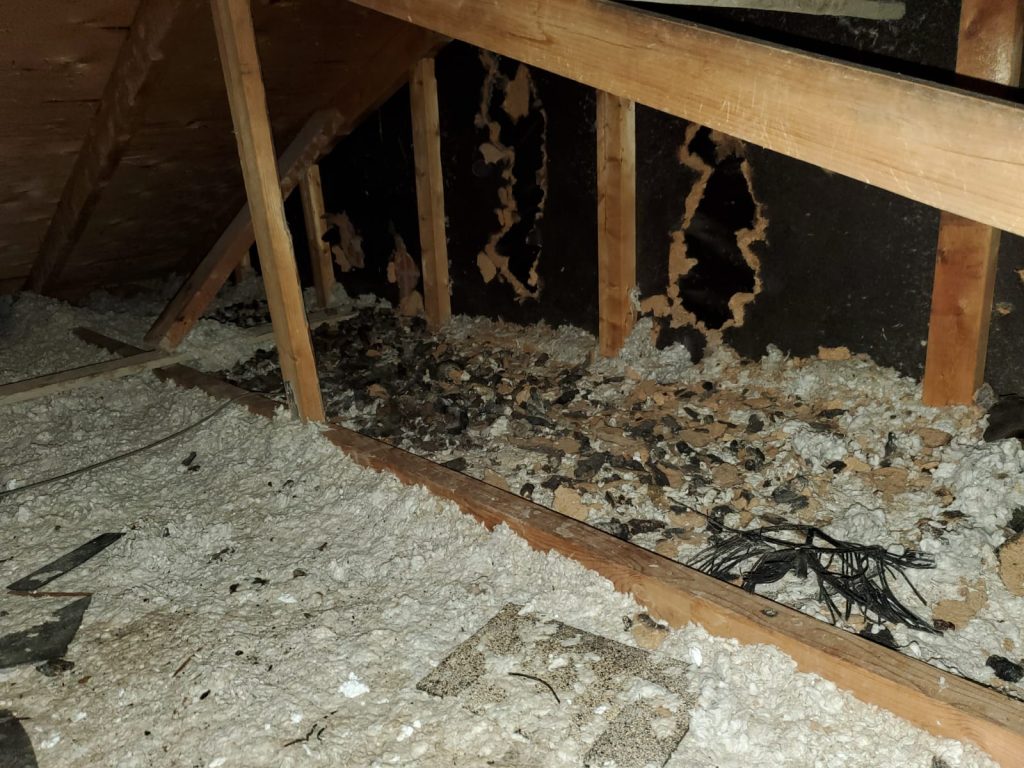

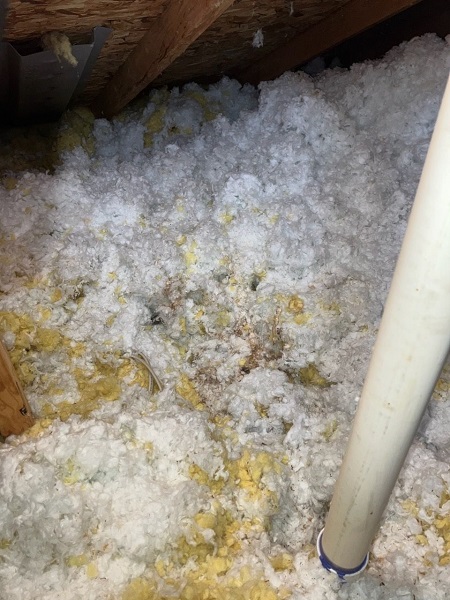

Beyond waste and noises, any damage is another way to confirm that a critter is living in your attic. If left unchecked, these critters can cause not only noise but damage as well. Stored items in your attic are at risk for nuisance wildlife damage. Squirrels and rats will use cardboard boxes and their contents to create nests.
Animals will destroy insulation. Raccoons will dig up insulation to create nests. Norway rats create burrows through it. Any animal in the attic will contaminate the insulation with feces and urine.
Raccoons will often tear up ductwork or wallpaper. Rodents chew the wood and the electrical wires—creating potential fire hazards—and rats will live in your attic, breeding in high numbers. Frayed electrical wires are a significant fire hazard.
Since they’re warm and often undisturbed by humans, attics make great nesting options for many unwanted critters. These pests seek shelter in attics to survive harsh weather during winter or raise young during the spring.
Many different animals enjoy living in attics. But here are a few of the most common:
- Raccoons. Raccoons are excellent climbers that will happily make your attic their home.
- Bats. Bats need a place to roost during the day, and your attic is the perfect spot.
- Squirrels. Squirrels of all kinds enjoy making nets in cozy attics.
- Rats. Rats can scurry up to the top floor of your abode to settle in.
- Mice. Mice are often found sheltering in human structures. The quiet attic space is a common spot where they fly under the radar.
- Birds. If given the opportunity, birds may make a nest in your attic.
Animals can enter your home through many different locations. The most common areas where we see animals entering are soffits, eaves, gable vents, roof returns, pipe stacks, any damaged areas on a property, and even any construction gaps. Rats can fit through entry points as small as the size of a quarter, and mice can fit into a gap just over ¼ of the size of a quarter.
Animals can even enter your home if there is not an entry point present. Raccoons are tenacious, resourceful, and strong. If they want to use your home as shelter, they will use their hands to create an opening. Raccoons can tear apart shingles and break through the plywood. Rodents like squirrels, mice, and rats constantly gnaw. Rodents easily create entry holes by gnawing through materials like wood, pipes, plastic, metal, brick, and electrical wires.
Chimneys
Chimneys, by definition, must be able to open to the sky to expel smoke, and many people don’t bother closing their flues.
Roof Ridge
The roof ridge provides another entry point. Most roofs have a ridge vent which raccoons can exploit the opening to create a bigger one. But raccoons don’t need to find a weakness. They have the strength and tenacity to tear through shingles and plywood.
Roof Edge
A fascia board is a thin longboard that runs along the lower outer edge of your roof and covers the entire roofline. Not only do fascia boards hold the gutters but also they provide ventilation. It is not uncommon to find a construction gap between the fascia board and the roof line.
Raccoons take advantage of the construction gap.
Loose Shingles
Raccoons have the strength and tenacity to tear through your roof. Shingles and plywood eventually succumb to a raccoon’s will. They don’t even need a large hole. For an animal that can be as large as twenty pounds, raccoons only need a gap the size of a grapefruit.
Soffits
A soffit is any finished material installed to cover the underside of the roof overhang. Soffits protect from the weather, bugs, mold, rust, and other pests. Raccoons can find gaps in improperly installed soffits or tear open a new entry hole.
Roof Vents
A home needs to breathe. Proper ventilation along the roof can extend the lifetime of your roof, improve energy efficiency in your home, and make the home a healthier place to live.
Ridge vents, box vents, and roof turbines remove stale air from your attic;, whereas soffit vents, gable vents, and over-fascia intake vents bring in fresh air. These vents also present a natural entry point for raccoons. Usually, the materials of these vents will stop a raccoon.
Plumbing Stacks
Rats and mice can use plumbing stacks to enter your house. Some rats are excellent swimmers and will climb through your toilets!
How to Find Animal Entry Holes
Pest animals can squeeze through surprisingly small gaps. A mouse only needs a pencil-sized hole. Pest animals can more easily access parts that are harder to reach for people. During the Critter Control inspection, we start where you notice an animal issue. From there, we investigate the different signs of animals in the attic. Paw prints, rub marks, and animal droppings usually point toward an entry hole.
The Critter Control expert will investigate the exterior of the roof. They have the experience to find the entry holes and training to do it safely.
Do not attempt to inspect your roof without proper safety equipment!
The inspection is essential for long-term wildlife control. We identify all current and potential entry holes. The whole home exclusion has solutions to properly seal all animal entry points.
Raccoons are omnivores so they have adapted to live in the urban and suburban environments in Greenville-Spartanburg. Raccoons, like most nuisance wildlife, are attracted to homes and yards that provide water sources, food sources, or shelter. Raccoons will drink water out of puddles, bird baths, buckets, or water bowls.
Why is a Raccoon in the House?
Homeowners are most likely to experience raccoon infestations during the spring and summer months. This period coincides with the breeding season for raccoons, which typically occurs from January to June, peaking around March and April in many regions, including Greenville, South Carolina. During this time, raccoons may seek out sheltered spaces to nest and raise their young, leading them to enter residential properties in search of suitable den sites.
Some of the most common areas for raccoon dens are the attic, the roof, inside the walls, sheds, and under porches or decks.
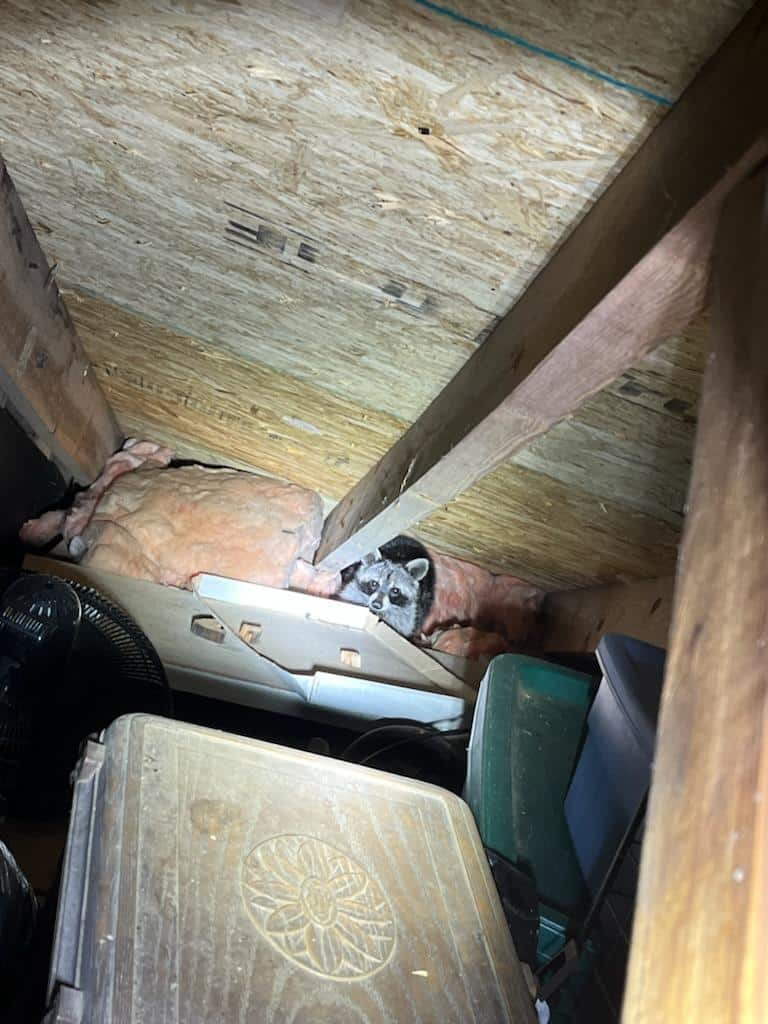
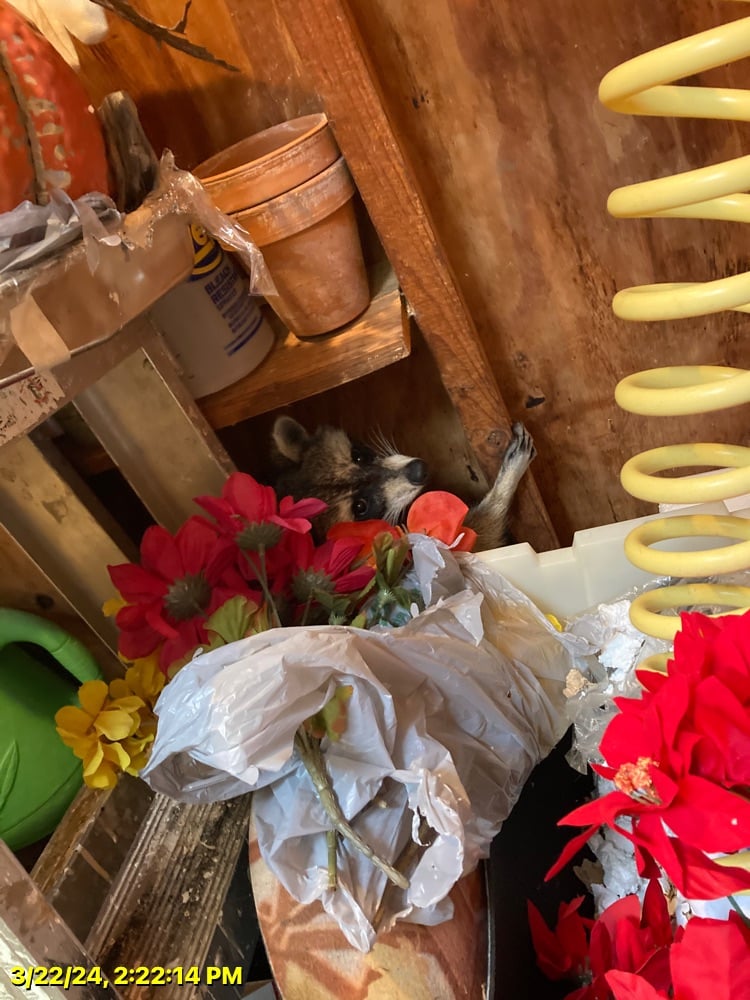
Juvenile Raccoons in Greenville, SC
Juvenile raccoons rely on their mothers to find safe shelters, and female raccoons frequently choose chimneys as denning sites. Raccoons are typically weaned between 8-12 weeks. This homeowner had a litter of raccoons in their attic and heard soft whining and crying. Raccoon pups make a variety of noises like mewing, crying, whining, purring, whimpering, and screeching.
How to Get Rid of Raccoons in Your Attic
The professionals at Critter Control have been trained with the most effective methods of removing raccoons from attics or from other areas of any home, as it can sometimes be a lengthy process to remove raccoons from the attic.
The best way to get rid of a raccoon is a trap. At Critter Control, we secure raccoon traps and set them away from anything you do not want to be destroyed. We place traps in an area where raccoons frequent. Because the raccoon trap needs to be checked, we do place it in a somewhat accessible location.
Critter Control uses only humane raccoon trapping techniques that are environmentally friendly and ecologically safe to remove raccoons from attics. Once the raccoons in the attic have been removed, our professionals can then identify the point of entry for the raccoons in the attic and repair this area to ensure you will never have raccoons in your attic again.
Photos and video provided by Critter Control of Greenville
The animals in Arizona have adapted to live in the desert climate. As people settled in the desert, they created new habitats for animals. Both agricultural and urban environments offer food, water sources, and shelter for wildlife. From scurrying rodents seeking shelter in suburban homes to elusive coyotes scavenging through neighborhoods at night, human-wildlife conflicts can become commonplace.
Wildlife Activity and the Drought
Arizona is in a cycle of long-form drought which impacts native wildlife. Water is the most important resource for animals in Arizona. During the drought, animals will congregate at established water sources. A few heavy days of rain won’t reverse the drought, but animals will have the ability to venture further from the established water source. After a rain, be aware of signs of a nuisance wildlife in your yard and house. You have an animal magnate if you have a water feature or a pool.
Breeding Season in Phoenix, AZ
Homeowners are more likely to experience nuisance wildlife infestation during the spring and summer because animals are looking for safe places to give birth. The most common spring nuisance wildlife in Phoenix are bobcats, raccoons, squirrels, and rattlesnakes. As we get closer to summer, skunks and bats become more of a problem.
Animals will create dens in your attic, inside the walls, or under decks and sheds. Animals like raccoons, bobcats, and squirrels will crawl into your attic to create a nest.
Skunks mate in the spring and give birth in the summer usually from May to June. Skunks will burrow under your deck to create a den to give birth.
The most common bat in Phoenix homes is the Mexican free-tailed bat. Mexican free-tailed bats (Tadarida brasiliensis mexicana) are highly social creatures that form large colonies for breeding and roosting. When selecting a maternity roosting location, these bats seek out environments that provide specific conditions conducive to successful reproduction and raising of young. These environments need to be warm, humid, dark and close to water.
Rattlesnakes give birth in August. Rattlesnakes prefer cool and damp places to give birth. As snakes are not capable of digging holes, it is common for rattlesnakes to make dens out of vacant rodent burrows. However, areas under your house like crawlspaces, basements, and porches provide a cool, damp location for a rattlesnake nest.
Signs of Wildlife in Phoenix
Some common signs of wildlife on your property include holes in your yard, damage along your roof, and disturbed garbage. Other signs of nuisance wildlife include strange sounds in your attic or walls, mysterious odors, physical damage to the home exterior, tracks or paw prints, and damaged insulation.
Wildlife Control in Phoenix, Arizona
Eliminating resources for animals will make your property less attractive to the critters. You can avoid a wildlife issue by removing food sources, limiting access to water, and cleaning up any debris piles.
If you are encountering a wildlife issue in Phoenix, call a professional. Females can be protective of their young. Attempting to remove an animal on your own, could lead to an animal attack. In some cases, simply stumbling onto an animal can be a problem. Surprised skunks will spray pets or people. Baby rattlesnakes tend to attack sooner than adults.
Andrew Cuen, the district manager for Critter Control of Phoenix, appeared on 12News to help educate Phoenix residents about wildlife activity.
Read the full article here.
Squirrels are cute but pesky critters who can create a lot of costly damage when they get into your home. Attics are an attractive nesting space for them. Out of harsh weather and hidden from predators, it’s an ideal space to raise their pups.
Getting rid of squirrels on your own can be a tough nut to crack. Yet many homeowners decide to take matters into their own hands and purchase readily available squirrel repellents to rid their houses of them. From chemical to natural remedies, here are some common types you’ll find in stores and online.
1. Repellent Sprays
Repellent sprays are a common choice because they are so easy to use. Natural sprays can contain capsaicin from chili peppers, peppermint, eucalyptus, garlic, and citrus oils. These are supposed to be smells that squirrels dislike. Sprayed on garden beds or bird feeders, they are supposed to fend off squirrels. These sprays have limited use as wind, rain, and time reduce their efficacy. In addition, squirrels are dogged creatures and will put up with these scents until they fade.
It’s important to note that there are no specific squirrel poisons available, as poisoning squirrels is illegal.
2. Ultrasonic Repellent Devices
These devices emit ultrasonic frequencies or electromagnetic pulses that create an irritating environment squirrels want to get away from. They are plugged into any electric outlet, and many are activated by a motion detector that switches on when the squirrel is close at hand.
These types of repellents have been growing in popularity as, unlike chemicals, they are seen as harmless to both the squirrels and house residents. However, there is no scientific evidence that these devices work, and the Federal Trade Commission has been warning consumers against them.
3. Granular Repellents
Granular repellents are typically made from natural ingredients, such as dried blood, predator urine, or hot pepper flakes. These granules can be scattered around gardens or outdoor areas to create a barrier that squirrels will avoid.
These have strong odors you would not want to use in your attic. Used outdoors, just like the spray deterrents, these will also fade away, requiring frequent applications. In addition, predator urine, such as fox urine, can attract fox predators like coyotes. And coyote urine can attract coyotes looking for a mate.
4. Motion-Activated Sprinklers
Motion-activated sprinklers are another recommended natural squirrel deterrent. When activated, they are supposed to startle and scare squirrels away. They might work on squirrels scampering outside, but most squirrels that nest in attics are tree squirrels that hop onto your roof from tree branches. These squirrels will not be affected by the sprinklers at all.
In addition, how you place the sprinklers is key. They need to spray the path the squirrels take to approach your home or garden bed. And squirrels can learn how to avoid the spray.
5. Taste Repellents
Capsaicin is a chemical that makes chilies hot. Squirrels do not like it. Effectiveness wears out quickly, so it requires constant reapplications. And it’s easy for squirrels to avoid. It might work to protect certain plants, but it won’t get a squirrel out of your attic.
Unfortunately, capsaicin can harm squirrels and other small animals that come in contact with it. If it gets on any animal’s paws, it could blind them if they then rub their eyes. This would jeopardize their survival, as it would make it impossible for them to find food.
The Truth About Squirrel Repellents and Deterrents
The internet is full of squirrel deterrent products, but none work well. There is no such thing as an effective squirrel repellent. Stores and the internet show products packaged in striking colors that they market as a cure-all.
The damage squirrels create when in your attic is serious. They gnaw on wood and wires, tear insulation, and make a mess with the nuts and acorns they’ll bring in. They also carry parasites and diseases and will become aggressive if cornered.
When you need to get one or more squirrels out of your attic, call a professional wildlife removal company such as Critter Control. We not only remove squirrels from your home but also exclude them from returning. Then, we sanitize and restore your space to its original condition.
Rats are one of the most common pest problems in apartment buildings. With multiple tenants going in and out of the building all day and night, rats have plenty of opportunities to enter. They mainly enter an apartment building to find shelter, food, and water.
When you notice signs of a rat, contact your landlord, building manager, or the building owner. They are responsible for deciding how to get rid of rats in an apartment. At the same time, there are many things you can do as a tenant to rat-proof your apartment. You must know the signs of a rat in an apartment to know what to do.
Recognizing the Signs of Rats in an Apartment
Seeing a rat, like when you flip on a light in a dark room and see it scurry into hiding, is the easiest way to know you have a rat problem. Other signs include the following:
- Rat droppings, up to 40 per night, by each rat living in an apartment building.
- Rat trails, or lines of rat droppings and urine, wherever they travel, usually from their nest to a food source.
- Rub marks on baseboards, walls, and floors from the grease and filth on a rat’s body.
- Footprints as they travel in dusty areas.
- Holes in baseboards, walls, or other areas chewed open by rats.
- Rat nests, which look like balls of debris, usually in dark and secluded areas.
- Hearing noises in your walls, ceilings, or floors like scratching, chirping, and scurrying.
- Smelling foul odors resembling ammonia but from rat urine and feces buildup.
Dangers of Having Rats in an Apartment
Having rats in an apartment building poses risks for all tenants and should be professionally eliminated immediately. One risk is that having one or two rats in the building can quickly become an infestation. Female rats can breed up to seven times annually, giving birth to seven or more pups each time. The females out of each litter are ready for breeding just three months after birth.
Another danger is that rats leave large amounts of feces and urine in areas where humans are, exposing you to the many diseases rats carry. If you breathe in spores that grow on their feces or touch their waste, you are at risk for diseases like tularemia, salmonellosis, and hantavirus.
Rats chew and gnaw on most materials, including electrical wires, drywall, wood beams, linoleum, carpets, and more. Damages can be costly and may even result in fires, structural failure, or injuries from tripping.
Rats can be aggressive. There are reportedly over 15,000 rat bites in the United States annually. Some of those bitten will acquire rat-bite fever, an infectious disease. Rat-bite fever is not the only concern.
Diseases Rats Carry
Rats carry numerous diseases and can transmit them to humans through bites, contaminated foods, and contact with their feces and urine. Diseases include:
- Hantavirus, spread by inhaling spores from rat feces, can lead to respiratory problems in humans.
- Leptospirosis, a bacterial disease spread through rats’ urine, can lead to severe flu-like symptoms and damage the kidneys or liver.
- Salmonellosis is a bacterial infection transmitted by eating foods contaminated by rats and can lead to severe digestive problems.
- Tularemia, a bacterial disease known as rabbit fever, can lead to skin ulcers, swollen glands, mouth sores, diarrhea, and pneumonia.
Because rats harbor fleas, ticks, and lice that can latch onto humans, they indirectly spread the following bacterial diseases: Anaplasmosis, Babesiosis, Lyme disease, Powassan virus, Borreliosis, Flea-born typhus, and Rickettsialpox.
These are just a few examples of diseases humans can contract directly and indirectly from rats.
Damage Rats Cause
Rats can cause extensive structural damage to an apartment complex by gnawing on structural supports and beams. They sometimes burrow under the foundation of the building, causing it to become unstable. Rats also gnaw on electrical wiring, causing interruptions in your electricity and, sometimes, fires.
Rats burrow in the insulation of apartment buildings, causing higher utility bills and leaving you feeling colder in the winter and hotter in the summer. They build nests in HVAC ducts, which can also lead to fires and send the spores growing on their feces directly into your apartment.
Rats can chew through plastic and some metals. If they chew through the building’s plumbing system, you could be left without use of your bathroom. If rats enter your apartment, they may disable your appliances by chewing through wires. They will also destroy any personal items, whether sentimental or not.
Top Tips for How to Get Rid of Rats in an Apartment
It can be tempting to try do-it-yourself methods for getting rid of rats in an apartment. But it is not as simple as setting traps with cheese or peanut butter. Each rat species may require specific baiting and trapping methods. Using the wrong technique can lead to more significant problems. You want to avoid causing further damage to your apartment.
If you are a tenant, inform your landlord, who handles problems like rat infestations. If you own an apartment, you must know the type of problem you have before getting rid of rats. Trapping and baiting can take weeks to months, depending on the colony.
Hiring professional rat removal services is the best way to ensure all rats are gone. They provide a thorough inspection and plan to treat the problem and prevent future infestations.
Sealing Your Apartment Against Rats
Even if you eliminate all rats from your apartment, you must prevent other rats from entering. Rats do not need much space to enter an apartment. They can squeeze through a hole the size of a quarter and flatten themselves to go under doors.
You may not notice every hole or crack in your apartment, but a professional wildlife expert will. They will also seal each one with proper materials. For example, they will use waterproof sealants to seal around leaky pipes. To seal vents, they may use steel wire mesh. Weatherstripping and spray foam may be necessary to seal other areas.
Removing Rat Food Sources
Rats will eat anything humans eat and anything your pets eat. A morsel of food falling under the oven, crumbs on your counter, and pet food left in a bowl entice rats. Removing all access to food in your apartment is crucial to avoid attracting rats.
Wherever you eat, clean up that space afterward to avoid leaving scraps and crumbs behind for rats. For example, if you like to eat on your sofa while watching television, don’t leave food or crumbs in or under it. Also, properly store foods, including pet foods, in airtight containers. If a rat gets into your pantry, it will contaminate all your groceries, which can be costly to replace.
Rat Traps, Poisons, and Repellents
Rat traps are the most common way people try to eliminate rats. They do not always work because rats are very clever and suspicious of anything new in their space. You must know where to place the trap, which bait to use, and how to safely handle the rat after trapping it.
Those who try poisons often find themselves with skin irritations if they do not use proper gear. It can take rats ten days or longer to take effect. Using poisons can leave you with rotting rats inside your walls, bleeding rats roaming your apartment, and health risks to you, your children, and your pets. Poisons can harm other wildlife, raccoons, birds, or squirrels.
Scent and ultrasonic repellents are available today to deter rats from entering your apartment. Neither option is poisonous, making them much safer than toxic options. Scent repellents use a rat’s sense of smell and the odors they don’t like to repel them from the building. Ultrasonic devices use sounds that rats do not like to hear. They may affect pets, however, so placing the ultrasonic devices out of range from your pet is essential.
Unfortunately, scent and ultrasonic repellents are not always practical. Rats develop tolerance to smells and sounds, and some are not bothered at all. As a renter, you must get permission from the apartment owner before using traps, poisons, or repellents. You do not want to cause further damage to the property or put other tenants and their children and pets at risk.
Working with professional companies to remove rats from the building is best if you own the apartment or are the landlord. They can help prevent tenants from accidentally encountering poisons or injuring themselves with traps. Sometimes, DIY methods prolong the need to call for help.
When to Call Professional Rat Removal Services
Many DIY methods for getting rid of rats are temporary solutions, if they work at all. Professional rat removal services offer effective solutions to eliminate rats in an apartment and prevent future rat infestations. They have safety equipment, knowledge about rat behaviors and habitats, and exclusion methods that offer tenants relief and assurance that their rat problem is over.
Critter Control offers thorough inspections before rat removal to assess the type and size of the infestation. Once complete, they will create a plan for removal, rat damage repair, and exclusion using proper equipment. Call them today or at the first sign of a rat. They are experts in how to get rid of rats in an apartment.
Mothballs are insecticides intended to kill clothes moths and other fabric pests. Controlled by the Environmental Protection Agency, they are illegal to use for any purpose or by any method that isn’t specified on the label directions. This article explores if mothballs are effective wildlife deterrents for mice, snakes, bats, and other creatures, and highlights important health factors based on existing research.
History of Mothballs
Before modern air conditioning and heating systems were commonplace, households sought out natural airflow to regulate indoor temperatures, which brought with it the invasion of pests eager to eat homeowners’ favorite clothing. In response, mothballs became the first line of defense, a key element of clothing care and preservation.
With synthetic materials like nylon and polyester now blended with natural fibers like cotton, moths rarely seek out clothing as a food source. Nonetheless, there are many advertised uses for mothballs in the house and outdoor areas for wildlife control, many of which are considered dangerous or illegal.
How Mothballs Work
Mothballs are round discs of solid pesticides with the active ingredient naphthalene, camphor, paradichlorobenzene (dichlorobenzene). These solid discs release vapors that are toxic to moths and moth larvae, eliminating them or deterring them from the area. However, to be effective for pest management, mothballs must be placed in airtight containers where moths are exposed to high concentrations of vapors.
Mothballs as a Wildlife Repellent
Mothballs are frequently suggested as wildlife deterrents in both indoor and outdoor areas. These solutions are ineffective, dangerous to humans and pets, and illegal in some cases.
Indoor
Mothballs are commonly made of naphthalene or paradichlorobenzene, both of which are toxic to humans and have detrimental health effects. Accidental mothballingestion is common in children. Fumes from naphthalene mothballs can escape into the air and can cause respiratory problems. High levels of fumes can accumulate in closed areas, and improper use of mothballs can lead to long-term exposures to people and pets. Medical issues as a result of mothball naphthalene poisoning include hemolytic anemia, methemoglobinemia, and in rare cases, kidney damage.
For these reasons, mothballs should not be stored in closets, crawl spaces, attics, basements, storage chests, garment bags, or other spaces excluding airtight containers.
Outdoors
Mothballs are occasionally thrown in gardens and lawns to keep away pets and other animals. However, mothballs are ineffective in repelling wildlife in outdoor areas such as rats, mice, squirrels, bats, snakes, or other wildlife. Mothballs may contaminate soil and water and their use as animal repellants is not appropriate and can be illegal.
Do Mothballs Ward Off Snakes?
Mothballs don’t repel snakes. As snakes are attracted to areas that provide cover and shelter, homeowners should remove log or trash piles close to the home and maintain grass or other vegetation to make the area less appealing.
Will Mothballs Repel Mice & Rats?
Mothballs contain naphthalene, but the small quantity in mothballs is insufficient to effectively deter rats or mice , and the smell rapidly dissipates. The smell can be a deterrent in large enough quantities, but will not prevent rodent infestation, on top of health risks.
Bats and Mothballs
Unfortunately, there are no magical products to repel bats, including mothballs. Similar to mice, naphthalene is an annoyance to pests, but not enough to prevent the species from occupying your living space.
Groundhogs and Mothballs
Filling a groundhog hole with mothballs is not effective, and increases the chance that the groundhog will simply create another den nearby until the smell dissipates, which happens rapidly. Groundhog-proof fencing or removal services are the only effective, guaranteed solutions.
Mothballs, Chipmunks and Squirrels
While chipmunks and squirrels dislike the smell of mothballs, mothballs are a less effective option relative to trapping and removal services. Mothballs are considered an inhumane alternative as chipmunks and squirrels may die after consuming. Lastly, the use of mothballs to deter chipmunks and squirrels may be illegal depending on your locality and is bad for the environment.
Do Repellents Work?
Natural repellents like predator urine, citrus ammonia, and mothballs have low effectiveness as deterrents.
Instead of using ineffective mothball solutions to deter mice or other wildlife species, contact Critter Control technicians who can tailor permanent solutions for your wildlife problem. Mothballs are ineffective deterrents of wildlife, and most importantly pose health risks to the inhabitants of a home.
The house mouse is also known as the Mus musculus. It is known for its large ears, pointed snout, and virtually hairless tail.
Mice are typically attracted to kitchens; we highly recommend storing all food in airtight containers for this reason. Mice will also gnaw on virtually any surface or material to get into a home, such as insulation, wiring, and wood. It’s not uncommon to also find mice in attics, crawlspaces, and garages.
Home owners will see signs of mouse damage typically before seeing an actual mouse. This is partly due to mice being more active at night. But it is not uncommon to see the mice scampering throughout their house.
The top 3 signs of a mice infestation:
- Droppings
- Nests
- Damage to food packaging
Mouse droppings are small and dark and usually found on kitchen floors near baseboards. Their nests can be found in hidden areas such as inside drawers or even mattresses. Pantry foods are the most common target for mice that have infiltrated a home, so start by checking the integrity of your food packaging in your pantry. Other evidence of a mouse infestation in the attic include damaged insulation, stripped electrical wires, and gnawed PVC pipes.
Where Do Mice Live in a Home?
Mice prefer warm, dark, and sheltered areas, such as wall cavities, attics, basements, and storage sheds. Mice can squeeze through holes 1/4 of an inch in diameter or larger. Because mice have powerful teeth and are highly motivated by available food and warm shelter, they can also easily create holes or enlarge existing holes to get inside.
How do mice get inside my house?
The most common entry points for mice are pipes, vents, and doors or windows attached to either the main house, or the garage.
Mice can climb any textured vertical surface and can jump over a foot off the ground. They can access uncovered vents, chimneys, windows with broken screens, and through utility pipes that run through exterior walls.
Mouse Infestation Prevention
It’s best practice to keep food stored in pantries in air-tight containers and to always clean up crumbs. Wipe down your cabinets and the insides of your cabinets regularly. However, cleaning the space where a mouse was found will not necessarily prevent mice from coming back; the only way to do this is by sealing up entry points.
Stop mice from getting into your home by making your yard less attractive to mice. Mice use dense underbrush and debris like leaves and twigs to take shelter from predators. Clearing yard debris will remove shelter for mice to hide under. Mice outdoors don’t pose as much of a threat as those indoors. However, the pests always have the potential to find their way inside homes to look for a meal or a place to nest.
How Critter Control Gets Rid of Mice
Mice trapping typically lasts five to fourteen days but that can change depending on the size of the house and how well established the mice are. The most effective mouse control method is exclusion repairs. This involves sealing off any current or possible entry points on the home, followed by a thorough inspection and sanitation process. It’s important to repair any damage the mice may have done to the house and disinfect any areas with mouse droppings.
About the author
Meg has over 13 years of experience in the wildlife industry. She started as a wildlife technician and was district manager and technical training manager supporting the Southeast Region. She currently is one of the company’s wildlife training managers. As one of the training managers, her primary focus is special projects and leading Women in Wildlife.
Critter Control Reviews
Skunks are attracted to areas with accessible food sources and shelter. By eliminating these attractants and implementing certain deterrents, you can reduce the likelihood of them entering your yard.
Lawns, especially newly created ones, are immensely attractive to skunks, as they tend to be heavily watered and loaded with worms and grubs. Skunks dig small holes where grubs are located, which can make your lawn ugly quite quickly.
How do you know a skunk is in your yard?
You can typically tell when a skunk is in your yard by their pungent/distinct odor. If you see signs of digging or upturned soil in your yard, it may be the result of skunk foraging.
When are skunks a problem in the yard?
Skunk problems are typically at their peak during three times of the year:
- Mating season (mid-February through mid-March)
- Birthing seasons (May–June)
- Winter foraging (approximately October–November) when skunks dig up lawns searching for grubs and worms
Skunk Mating Season
Mating season involves skunks seeking mates — and this often occurs nears homes. Homeowners report skunk tracks in the snow or smell skunk spray. Skunks secrete spray when they are mating and males often spray when they’re fighting and feel threatened.
Birthing Season
The season of skunks’ birth is a precarious one for removal — we can either relocate the entire family, including mother and babies, or we can seal off the areas that skunks are inhabiting and install a one-way valve that allows the family to exit but not re-enter. This can only be done when young are able to walk (3+ weeks).
The very last thing we want is to separate a mother from her kits. When we trap skunks, we always inspect the gender of the animal to ensure we aren’t accidentally relocating a mother who may get separated from her young on your property Many wildlife companies may not attempt the extra care of not separating mothers from their babies, but Critter Control of New Hampshire considers it a necessary step.
Skunk Winter Foraging
When skunks forage in lawns, it can often look like someone ran a rototiller across your yard. In some parts of the country, fall brings rain, which saturates the soil and brings earthworms to the surface. This provides easy access to a food source for skunks.
Skunk control for your yard
Skunks are attracted to the worms and grubs in your lawn and garden. Lay down 1-inch mesh chicken wire, securing it with stakes or heavy stones.It’s also important for homeowners to prevent access to denning sites, as skunks will readily den under houses, sheds, or porches if given the chance. Close off these areas with ¼-inch hardware cloth, boards, or metal flashing. Make all connections flush and secure, and you’ll keep out smaller animals like mice and rats, too.
Each state has their own laws and regulations regarding skunk removal. Homeowners should avoid attempting skunk control themselves and should instead call a professional due to the risk of rabies and diseases transmitted through skunk bites, as well as potential property damage from their foraging and sharp claws.
About the author
Meg has over 13 years of experience in the wildlife industry. She started as a wildlife technician and was district manager and technical training manager supporting the Southeast Region. She currently is one of the company’s wildlife training managers. As one of the training managers, her primary focus is special projects and leading Women in Wildlife.
Critter Control Reviews
It is a crisp, clear summer night. A full moon hangs bright white in the sky, and the stars seem to align just right, as you get ready to go to bed.
Just as you’re cozying up, suddenly, you hear the sound of a scratching noise coming somewhere from the attic.
Feeling uneasy, you head toward the unfamiliar noise with a flashlight. And after a few minutes, meet with two neon-studded eyes of a raccoon glaring back at you.
What are your next steps? It is a crisp, clear summer night. A full moon hangs bright white in the sky, and the stars seem to align just right, as you get ready to go to bed.
Just as you’re cozying up, suddenly, you hear the sound of a scratching noise coming somewhere from the attic.
Feeling uneasy, you head toward the unfamiliar noise with a flashlight. And after a few minutes, meet with two neon-studded eyes of a raccoon glaring back at you.
What are your next steps?
How Raccoons Enter Your Home
In recent years, more raccoons than ever are flocking to densely populated towns and cities. The lack of natural predators, the never-ending food supply, and the safety of our homes provide them with everything they need in order to survive.
The raccoon population has enjoyed an “astonishing” surge over the past 80 years, according to zoologist Sam Zeveloff. They’re apparently at highest density in the suburbs, but they appear to be also growing in cities.
Raccoons may at first look furry and cute, but don’t let their exterior fool you. They are smart, curious, and extremely determined to do anything to make your house their den site.
There are many ways a raccoon can break into your home like:
- Tore open soffit
- Open vent hole
- Tore open walls
- Roof vents
- Roof edge
- Crawl Spaces
- Open doors and windows
- Attic
- Chimney
- Basement
- Pet doors
Dangers of Raccoons in the Home
Raccoons are pesky critters that can wreak havoc on your healthy living space and environment.
If spotted in your home, it is best to avoid interacting with them at all costs. You may want to contact a professional wildlife removal company like Critter Control immediately.
To protect your family from diseases and other parasites raccoons often come with, it’s important to be aware of some of the risks and signs to watch out for.
Below are a few of the health risks associated with raccoons.
- Raccoons are known to be carriers of zoonotic diseases such as leptospirosis and rabies.
- Their feces can contain roundworm eggs that can be spread to humans or pets.
- Once inside your home, raccoons can breed and spread more harmful diseases.
Furthermore, in the very little time they are in your house, raccoons are capable of destroying your insulation and scavenging on just about anything they find. Attics, chimneys, and sheds offer them the warmth and shelter, making it an ideal place to mate, raise families and keeping out of the cold.
Prevent Raccoon Intrusion
Similar to humans and most other animals, raccoons have three basic needs for survival: food, water, and shelter. Your home provides many opportunities for each.
Here are a few factors that make your home attractive to raccoons:
- Food: Easily accessible food through feeders, fallen fruits, and trash cans
- Shelter: Woodland environments are their natural and preferable shelters because they mimic their natural environments.
- Mating: During Springtime, female raccoons look for a safe space (warm and dark areas) to raise her young.
Ultimately, the best way to protect your property is through prevention. Here are a few measures you can take to keep raccoons away.
Install Chimney Caps
Chimneys are a standard route of entry for raccoons. Raccoons are naturally attracted to nesting spots that are warm, safe, and secluded for protection. If your home has a chimney, installing a chimney cap can help prevent raccoons from entering.
Landscape Your Yard
Raccoons are infamous nightcrawlers that target suburb roofs. Your roof is more accessible to raccoons with lots of overhanging trees and branches. Trimming or removing these kinds of trees can make it harder for raccoons to climb onto your roof and enter or damage your attic.
Protect Your Trash
Raccoons can’t resist trash, so you’ll need multiple strategies in this area. Secure non-locking trash can lids with bungee cords or cinder blocks. Double-bag waste meat items to reduce the odor. If possible, keep trash in your garage at night, and bring it out for pick-up only.
Fence the Garden
Since raccoons are skilled climbers, the most effective fence to install is electric. Use a 2-wire electric fence, placing wires 6 and 12 inches above ground. Set the fence on a timer set to run only after dark.
Remove Food
Just like most pets, raccoons can’t resist the smell of nearby food. Gather any rotten produce or fallen fruit in veggie gardens or laying in the grass. Bring bird feeders indoors at night or hang them in a spot that isn’t accessible to raccoons.
Keep Pets Secured
Speaking of food, place pet food inside overnight as well as your pets. Raccoons carry rabies and other diseases that can be passed along to your furry friend. Make sure to routinely give your pets their shots to help protect them from the parasite’s raccoons pass.
When it comes to raccoons, you first have to get them out to keep them out. If you’re worried about the dangers of raccoons near you, call Critter Control today for a free inspection.
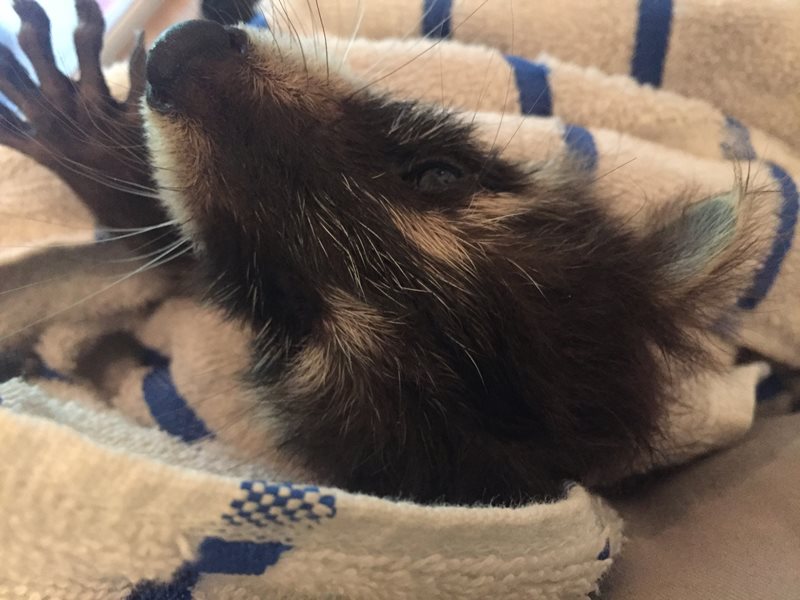
As cute and cuddly as raccoons may look, they are not pets, and should not be treated like pets.
Raccoons are wild animals that can cause severe harm and damage under the confines of a home. Unfortunately, keeping a raccoon as a pet is rare for a reason. They are not bred to coexist with humans in a domestic environment like most dogs and cats.
Before you let one of these masked bandits live in your house, first consider these 7 reasons why it’s probably not a bright idea.
1) Rabies and Other Infectious Diseases
Studies show that raccoons make up nearly 30% of all rabies cases in the United States. Raccoons are also known to carry zoonic parasites and infectious diseases that can spread to you, your family, and your pets.
Additionally, raccoon droppings can may raccoon roundworm; a parasitic worm that can harm both humans and pets. The egg spores in the raccoon droppings are light and can quickly become airborne, resulting in a dangerous infection.
2) Behavior and Temperament
Raccoons are smart, curious, active, and playful animals. However, they are also demanding, attention-seeking, and unpredictable.
Born to roam wild, raccoons act out when held captive. When trapped in confinement, they will use their long, dexterous, tapered fingers and nails to pry their way out.
Simply put: Adopting any wild animal as a pet is extremely dangerous. Their instincts will often override any “training” you try to impart on them, and they will always act in unpredictable ways.
3) Known to Act Out if Unhappy
When upset or moody, raccoons can act like hormonal teenagers. These selfish critters can turn vengeful, aggressive, and territorial in an instant all to assert their dominance.
“Once they hit sexual maturity at about six months of age, they are no longer gentle and cuddly,” wildlife expert, David Seerveld stated. He goes on to explain, “suddenly and without warning,” your adorable, gentle pet can flip a switch and “bite your face off.”
Their tendency to act out makes interacting with others close to impossible. In a human home, raccoons often feel trapped—which can stir up extra agitation and hatred to fuel the fire.
4) Damage to House
If you haven’t already noticed, raccoons aren’t the most considerate of animals. As wild animals, they get irritable if caged in one place for too long. Once let out, they will explore every square inch of your house.
Translation? Say hello to torn and scratched furniture, chewed-up cords, and broken valuables everywhere.
Everything must be not only child-proof but also raccoon-proof? Now that’s a lot to ask for.
5) Say Goodbye to Your Time and Money
Taking care of a raccoon as a pet is a full-time job that can break the bank over time. To make sure a raccoon doesn’t escape; you would need to invest in an expensive cage that locks and is sturdy enough to handle a lot of shenanigans.
Then, add on the cost of house damage repairs from emotional outbursts and mischievous behavior. It all adds up.
6) Nearly Impossible to Potty Train
Due to their stubborn nature, raccoons can be difficult to potty train.
While they can be trained to use a litterbox, if you irritate them, they will willfully punish you by having accidents around the home; raccoons hold grudges!
7) Adapted to a Nocturnal Lifestyle
As nocturnal species, raccoons are most active at night. For raccoons held in captivity, this can pose a problem, as most humans sleep during the night. Pet raccoons may keep you up at night by scratching their cage or escaping and causing trouble in your home while you sleep.
As winter approaches and cold weather settles in, animals are looking for places to stay warm. There are a number of ways that nuisance wildlife will den or nest on our properties and in our homes, and there are few measures that can be taken to help prevent and address these behaviors.
Like humans, critters prefer to stay warm and protected from the elements during cold weather. Attics and crawlspaces provide wildlife with warmth, nesting materials, and safety they need to survive during cold temperatures.
Common Winter Pest Animals
The most common pests we see moving indoors during the colder months are squirrels, rats, mice, raccoons, and opossums. It’s important none of these animals hibernate. So if they are in your home to escape the cold weather, they’ll continue to be a nuisance.
Bats in the winter can pose a unique problem. Some bat species hibernate while other species migrate. If you live in a colder climate, you might have hibernating bats in your attic.
We do not remove hibernating bats, we will repair everything on the structure with the exception of where the bats are roosting until temperatures warm up and the bats start moving again. There are some parts of the U.S. that will have migrating bat problems. For example, homeowners in the Rio Grande area of Texas can have migrating bat problems. In those cases, we can remove bats immediately.
How to Prevent Nuisance Animal Problems During the Winter
It is important to keep a well manicured lawn year around, but especially during seasonal changes. Piles of leaves, debris and overgrown bushes and branches can offer a warm, safe environment for critters to nest or den. Additionally, keeping all food/household waste in tightly sealed garbage bins, along with keeping up any outdoor pet food will help deter nuisance wildlife from being attracted to the property.
It’s crucial to conduct routine inspections of your property and to have any entry points sealed by a wildlife control professional to stop and prevent unwanted pests from coming in.
All structures, whether houses, apartments or commercial properties, can have a variety of entry points for pests to make their way inside for warmth and shelter. Chimneys, ground and roof vents, soffits, rooflines, decks and siding all have different types of intentional and unintentional gaps as a part of their structures. As a reference point, both mice and bats can get into spaces less than an inch large.
Costs of Nuisance Wildlife Damage
Nuisance animals can cost hundreds or even thousands of dollars worth of damage to wood, plastic, metal, and insulation in your home such as electric wiring, plumbing pipes. They can also cause this damage very quickly. If you believe you have a nuisance wildlife issue, it is recommended to call a wildlife control professional immediately. This winter, stay one step ahead of these critters and take the proper steps to transition your home to keep the warmth in and the critters out!
About the Author

Meg has over 13 years of experience in the wildlife industry. She started as a wildlife technician and was district manager and technical training manager supporting the Southeast Region. She currently is one of the company’s wildlife training managers. As one of the training managers, her primary focus is special projects and leading Women in Wildlife.
Testimonials

The house mouse is also known as the Mus musculus. It is known for its large ears, pointed snout, and virtually hairless tail.
The Virginia opossum is the only marsupial the lives in North America. Opossums have adapted to live in urban and suburban environments.
Benefits of Opossums in Your Yard
Opossums provide natural pest control. Opossums are omnivores and will eat a wide variety of foods including pests such as insects, ticks, small rodents, and even scavenge animal carcasses and roadkill. The opossum diet changes slightly depending on the season. For example, the pests eat a lot of insects in the summer while they mostly consume small mammals in the winter.
How to Attract Opossums to Your Yard
Providing resources for food, water, and shelter can attract opossums. They prefer to nest in tree cavities or abandoned dens of other animals but will often times take up residence in unoccupied attics, garages, sheds, or beneath porches. Opossums are opportunist and will take advantage of any area that they deem suitable for shelter. With that being said, the same things to attract opossums can also attract raccoons, skunks, squirrels, and other nuisance wildlife.
Are Opossums Dangerous?
Opossums are not likely to attack humans unless provoked, but they can damage your property, especially if they take up residence in an attic, barn, shed, etc. Opossums will steal eggs from chicken coops. They make a mess rummaging in garbage cans and eating left out pet food.
How to Prevent Opossums
To keep opossums out of your yard, you need to keep in mind what initially attracts them to it to begin with: food. Opossums are willing to eat just about anything, so be sure to keep your yard food-free:
- Keep all garbage and food scraps tightly sealed, so there’s no obvious food sources lying around for them to inspect and chow down on.
- Keep your yard well groomed. Be sure to pick up sticks, keep your leaves raked and your grass mowed. Failure to maintain your lawn could attract snakes, rodents and other critters that will, in turn, attract opossums to come along in hopes of eating them.
The best way to keep opossums from getting into your home is to physically prevent them from entering. This can be done by conducting annual inspections of your home’s exterior. Amid that process, be sure to:
- Plug any gaps along your home’s foundation
- Cover vents with metal vent covers
- Attach metal flashing or quarter-inch hardware cloth to protect other openings that must be maintained for airflow or exhaust.
Biggest Opossum Myth Debunked
The biggest misconception surrounding opossums is that they are carriers of rabies. Opossums are rarely known to contract rabies and are even less likely to pass it on to other organisms. One interesting fact about Opossums is they are the only marsupial (pouched mammal) in North America. Additionally, Opossums are known to “play dead” when frightened.
About Meg Pearson
Meg has over 13 years of experience in the wildlife industry. She started as a wildlife technician and was district manager and technical training manager supporting the Southeast Region. She currently is one of the company’s wildlife training managers. As one of the training managers, her primary focus is special projects and leading Women in Wildlife.
Contact Form
Critter Control Reviews
Georgia is home to sixteen bat species, and they can live in every region of the state. A suitable bat habitat has close acccess to water, ample food supply, and a safe place to roost during the day. Natural roosting locations include caves and hollowed trees.
Suburban and agricultural landscapes provide similar habitat requirements. Bats will roost in mines, under bridges, in bards, in your attic, inside the walls, or on your roof. Of the sixteen bat species in Georgia, the only three bats typically roost in homes. If you have bats in it is likely the little brown bat, big brown bat, or Brazilian free-tailed bat.
Who to Call for Bat Removal in Atlanta, Georgia?
You should call a licenses Nuisance Wildlife Control Operator in Atlanta because bats must be removed from structures through a process of exclusion, not extermination. As per our state laws, intentionally capturing, killing, and harming bats are illegal. This restriction applies to all 16 bat species found in Georgia.
Why are Bats Protected in Georgia?
Out of the 16 local bat species, five are tagged as species of concern within the state. The Indiana bat and the gray bat, meanwhile, on the list of federal and state endangered species.
Bat species currently listed as endangered on the federal level include the Indiana, hoary hat, gray, Florida bonneted, and little Mariana bats. In addition, the Mexican long-nosed, Pacific sheath-tailed, Virginia big-eared, and Ozark big-eared bats are listed for protection.
The federal threatened list includes the Mariana fruit bat and the Northern long-eared bats, while the tri-colored and little brown bats are under review for being endangered.
Benefits of Bats in Georgia
All bats in Georgia are insectivores (no vampire bats). Some small bats can consume up to 1000 small insects in a single hour. A nursing female bat can consume more than 4000 insects a night. It is estimated bats save U.S. farmers roughly $23 billion each year by reducing crop damage and limiting the need for pesticides.
Bat Populations in Georgia Threatened
Despite the benefits bats provide, the bat populations are threatened.
- White-nose syndrome is a fungal disease that spreads through bat colonies and has almost eliminated the Northern long-eared, little brown, and tri-colored bats.
- Bats do not reproduce as quickly as other wildlife. The females typically give birth to one or two pups a year. Slow reproduction puts the species at risk for population decline.
- Pesticides used by farmers reduce the number of bugs available for bats to eat.
- Wind turbines kill hundreds of thousands of migrating bats around the world.
Roosting Bat Concerns in Atlanta
Bats provide tremendous value; however, you do not want bats roosting in your house. Bats pose very little direct danger to people, but they can spread diseases and damage your property.
Bats defecate where they roost. Bat droppings, or guano, can accumulate within walls and attics as well as on the ground and roof tiles. The nutrient-rich droppings cultivate the growth of histoplasmosis fungus, which causes severe respiratory problems in humans.
Bats are indeed capable of contracting and transmitting the rabies virus. Rabies is transmitted via scratch, bite, or when infected saliva comes into contact with human eyes, mouths, or open wounds. So if you find bats in your house, avoid contact!
Bats also harbor ticks and fleas. Those parasites can find new hosts like your family and pets.
Bat Removal in Atlanta, Georgia
To get rid of bats in Georiga, you need to use exclusion not exterminator. In the state of Georgia, not only is it illegal to kill or trap bats, but also you should avoid evict bats from your home if flightless pups are present.
Bat Exclusions Restrictions in Georiga
Bat issues can happen to any home at any time of the year, but they are most common during maternity season. Bat maternity season in Atlanta, GA lasts from April 1st–July 31st. During this time, you should avoid bat removal.During this time of year, bat pups are too young to fly and may become trapped and die inside structures. If exclusions must be completed during this maternity period they must be completed by a licensed Nuisance Wildlife Control Operator like Critter Control.
Spring is ideal for bat removal as it coincides with their return from hibernation or migration but before maternity season starts. After maternity season, the bat colony disperses. Some bats return to the same roost year after year. If you want to prevent bats from entering your home, preventative exclusion is the best precaution you can take.
How to Get Rid of Bats
The most effective and humane way to remove bats is by utilizing a bat valve in conjunction with a full home exclusion. A bat valve allows for bats to exit your home but not re-enter. Since each bat removal is unique, our specialist will use or create a bat valve specifically for your home.
Once the bat valve is installed, all other entry points will be sealed, allowing for bats to exit only through the valve. The removal process typically takes 3-7 days. Our specialist will perform a final attic inspection before removing the valve. After removing the valve, the final entry point will be sealed, leaving your home bat-free.
Pictures of Bats in Attic
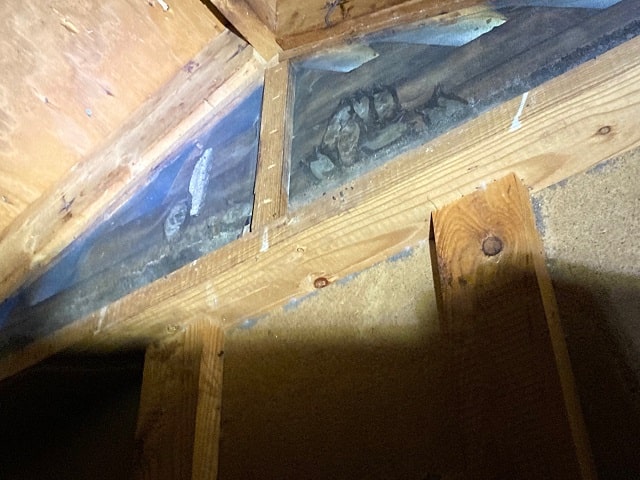
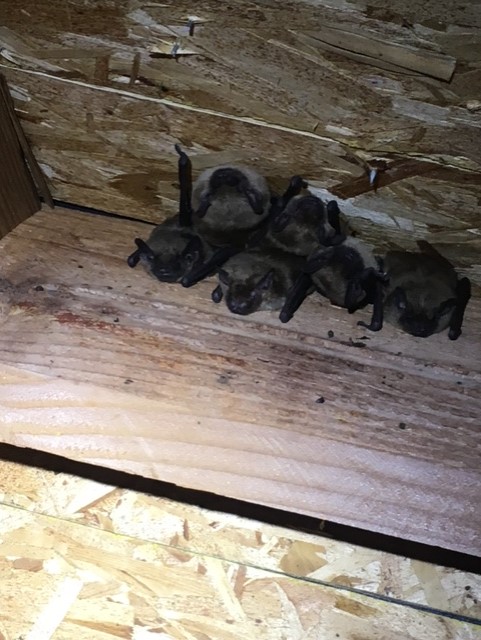
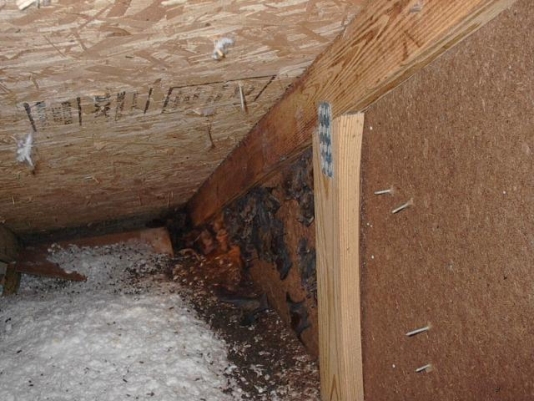
Bat Guano Identifcation – Signs of Bats in Attic
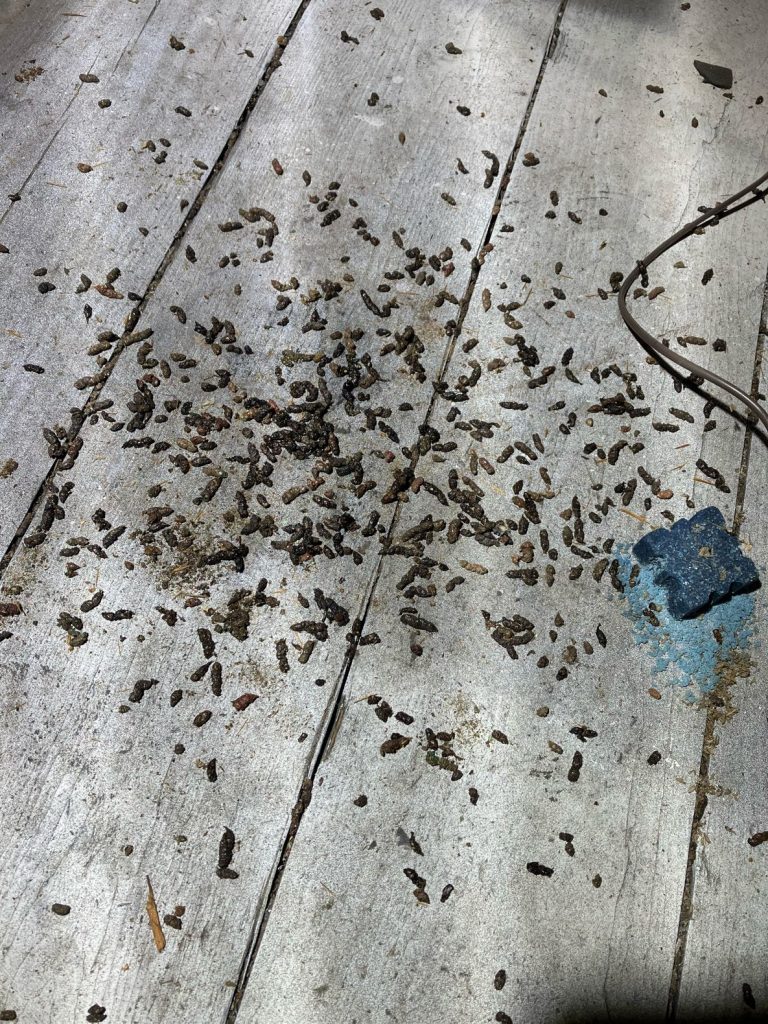
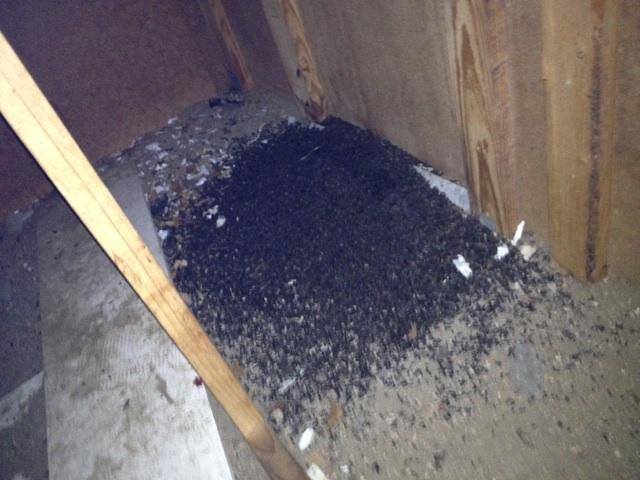
How Bats Get into Your House
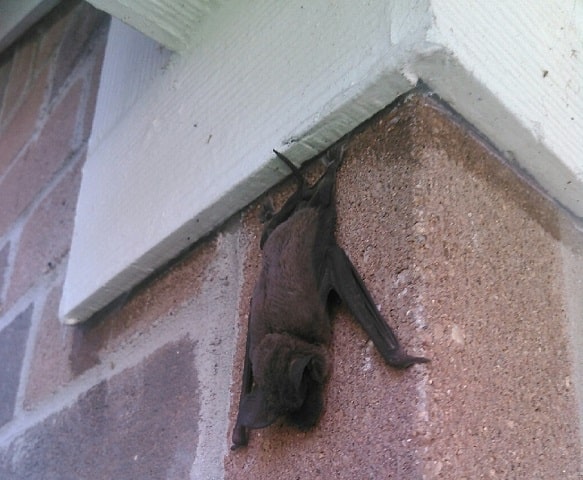
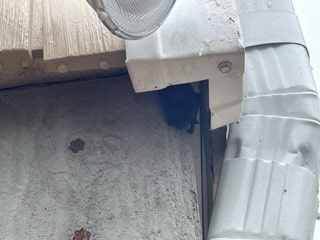
Bat Exclusion with Custom Bat Valve
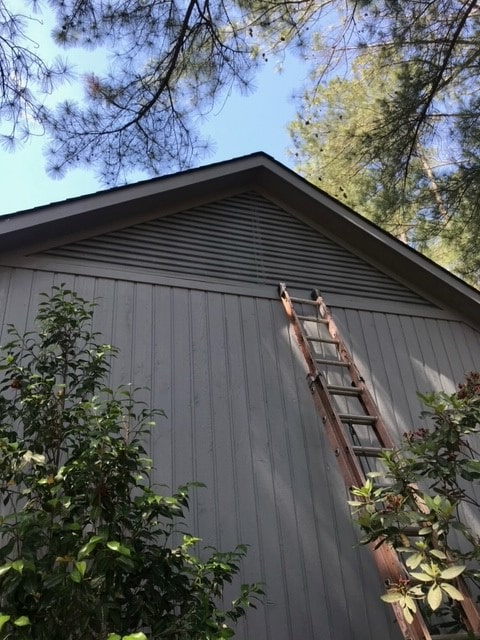
_1.jpg)
.jpg)
Contact Form
Reviews of Critter Control in Atlanta, Georgia
All Illinois bats are protected under the Wildlife Code (520 ILCS 5/1.1).
Bats may not be shot, trapped, transported, or held in confinement except when a bat is found in an area where they may have contact with humans or domestic pets.
Where Do Bats Live in Illinois?
The cave regions of southern Illinois and the valleys of the Mississippi, Illinois River, and Chicago River have ideal natural bat habitats and the highest abundance of bats. Big brown bats, little brown bats, Northern long-eared myotis and tri-colored bats are all colonial bats.
Bat exclusions can be installed when outdoor temperatures exceed 50° F at dusk. Insects are not active at lower temperatures, and all bats in Illinois are insectivores.
When Can You Remove Bats in Attic in Illinois?
Between May 15th to August 5th, you cannot get rid of bats from your attic.
During the spring and summer, females will form maternity colonies in the hollow of trees, attics, or little used buildings. If you find a group of bats in your attic during the spring and summer, tread carefully.
At birth a young bat clings to its mother. When the mother feeds each evening, the young bat is left in the attic. If one were to implement bat removal at this time, the young bats would be stranded inside the attic with no way to feed.
After about three weeks, the young can fly and will start feeding on insects, but they will continue to nurse until they are about 1½ months of age. Once the pups can fly, we can install bat exclusions and a one way valve to get rid of bats in your attic.
Some skill is required to identify all potential entry points because bats can enter through holes as small as 3/8″ (the diameter of a dime) or spaces 3/8″ by 7/8″.
Bat Removal during the Winter in Illinois
During the winter they usually roost in mines and caves. If natural habitats aren’t available, bats will winter inside buildings. If able, leave the bats alone for the winter and install exclusions once it gets warm.
They enter a state of bat hibernation called torpor. To survive long periods without a meal, the animals slow their breathing and heart rate to fall into a deep sleep. Unlike true hibernation, bats in this state can wake briefly on warmer days and leave their roost to find meals.
If bats are evicted during one of these warmer months, they won’t have a safe place to return when the temperatures drop again.

Raccoons, like most animals, are attracted to homes and yards that provide water sources, food sources or shelter. Raccoons will drink water out of puddles, bird baths, buckets, or water bowls.
Raccoons are omnivorous and are not picky when it comes to food. Your yard provides plenty of food sources. Raccoons are attracted to vegetables gardens (especially sweet corn), fallen fruit, birdseed, compost, outdoor pet food dishes, or, most famously, unsecured trash cans.
Other sources of food for raccoons are grubs in your yard, fish ponds, and chicken coops (raccoons will eat chickens and their eggs). If you have any easily-accessible sources of food in your yard it is likely you will run into nuisance raccoon issues at some point.
What are some signs that a raccoon has been on your property recently?
The telltale sign is damaged or overturned garbage cans, garden damage, or holes in your yard. Homeowners can also find damage on the siding of their house, in the eaves, soffit, and along the roof.
What kind of damage can raccoons do both indoors & outdoors?
Raccoons are very strong and can quickly cause damage to both indoor and outdoor areas of the home.
On the exterior, Raccoons can ruin vegetable gardens and tear up lawns looking for food like insects, grubs, and earthworms. Additionally, they can cause damage to crawlspaces and sheds if they decide to use them as a denning space.
Raccoons will use their intelligence and know where to use their strength to exploit your home’s weaknesses. If raccoons cannot find easy access inside, their paws allow them to grip and rip into materials commonly found on homes to create access points.
Raccoons are excellent climbers and can climb onto your roof. They can tear up the shingles in your roof to get into your attic and, once inside, they can destroy vents, soffits, insulation and much more, while establishing their dens.
What dangers should homeowners be aware of when dealing with a raccoon problem?
Raccoons are very dangerous to interact with. Though they are typically shy animals that retreat when they sense nearby humans, many of them are growing more and more accustomed to human interaction, as their natural habitats are threatened and decrease. Raccoons can be aggressive. They are most likely to behave aggressively if backed into a corner or are in a situation where they are protecting their young.
Before attacking, they will try to intimidate you by rounding their backs, sticking their fur out, elevating their tails, jumping repeatedly and showing off their claws. They’ll also growl, hiss and shriek at you, in an effort to get you to back off, before they’re forced to physically engage.
Even if a raccoon seems cute and friendly, homeowners should never approach them inside or outside their home (and definitely do not keep them as a pet!).
Do raccoon deterrents work?
Deterrents can be hit or miss; it all depends on the raccoon. Remember: these are very intelligent wild animals; what works to deter them one day might not work the next. If they want to get into your house, they might try several different ways and look for many different entrance points, so deterrents, both natural and manmade might not always be effective.
Homeowners can try repellents like peppermint oil, spicy peppers, garlic, vinegar, citrus peels, ammonia, and fox or coyote urine, but, again, these likely will only work in the short term, if at all.
How do you actually keep raccoons away?
If you want to stop them from hanging around your house altogether, you need to have them rule out your property as a potential shelter, food and source. So, homeowners should:
- Secure their trash cans
- Remove any pet food during the overnight hours
- Remove birdfeeders
- Empty standing water
- Block areas under porches
The most effective way to keep raccoons out of your house is to:
- Seal all vulnerable areas such as roof returns, any loose soffit, and holes that a raccoon might see as a way to enter your home
- Secure vents, chimneys, crawlspaces and basements
- Install tree and roof barriers to prevent climbing
- Keep all tree limbs trimmed back away from the house
At the first sign of a raccoon infestation, it is recommended to reach out to a wildlife control professional right away. The more established an adult raccoon den is on your property or in your house, the more damage it causes. A wildlife removal professional will use a combination of raccoon traps and exclusions to get rid of the raccoons.
About the author
Meg has over 13 years of experience in the wildlife industry. She started as a wildlife technician and was district manager and technical training manager supporting the Southeast Region. She currently is one of the company’s wildlife training managers. As one of the training managers, her primary focus is special projects and leading Women in Wildlife.
Get them out.
Keep them out.®
Experiencing a wildlife or pest issue? We can help! Complete this form and your local Critter Control® office will contact you to assist.
The most effective squirrel control is exclusion repairs. Squirrel trapping on solves the immediate problem but still leaves your house vulnerable.
Squirrels’ damage usually comes from their chewing and gnawing. Squirrels can squeeze through a hole the size of a golf ball. Squirrels can chew through siding, wood, metal, and shingles to gain access to your attic.
Squirrel Damage Repairs
Squirrels only need a gap a few inches to gain etnry to your home. Their sharp teeth can gnaw through most house materials, and a squirrel won’t stop gnawing just because the hole is big enough. Once the squirrel has been removed, you need to repair the entry points to keep other squirrels out.
Contact Form
Critter Control specializes in returning your attic to pristine condition after a nuisance animal infestation. Critter Control technicians have the training and experience to safely remove an animal, repair the damage, and install exclusions for a long-term and holistic solution.
Animals in Attic Damages
If an animal has been living in your attic, it has damaged it. Damage can include contaminated insulation, destroyed insulation, or damaged air ducts. An animal in your attic also introduces health risks like histoplasmosis or leptospirosis.
Dens and Nests
Wildlife will create dens and nests with the available materials in the nooks and crannies of your attic space. Dens and nests are often made using your insulation or HVAC ductwork, but animals can also use cardboard boxes, clothe, paper, and anything available. Dens and nests can reduce the energy efficiency of your home and destroy stored items.
Squirrel’s Nest in Insulation
Insulation Removed by Squirrel
Droppings in Attic
Feces and urine from any animal infestation not only create terrible odors but also cause structural damage to your home. Animal droppings will contaminate the insulation and reduce the r-value. Feces and urine can rot and contaminate wood, and ruin stored personal items in the attic. Animal feces in the attic may also lead to stained ceilings and drywall. and terrible odors.
Rodent Droppings in Attic
Raccoon Damage in Attic
Attic Insulation Services
The proper amount of attic insulation will help reduce your energy bills. Contact Critter Control to inspect your current insulation level. Our technicians can install new insulation to bring your attic up to the recommended level of insulation.
Many insulation materials can be difficult to work with. Let the professionals at Critter Control of Indianapolis complete your attic insulation installation. We will remove attic insulation that has been soiled and damaged with wildlife droppings and dispose of it.Raccoon Damage in Attic Repair
New Insulation Installation
Full Attic Restoration Process
In certain cases, a full attic restoration is necessary.
Step 1: Remove all current insulation in attics and remove large feces by hand with protective gloves or an industrial vacuum
Step 2: If necessary, remove the small feces from the attic using a HEPA-filtered vacuum.
Step 3: Fogging the entire attic with a disinfectant-virucide-deodorizer.
Step 4: Replace soffit baffles and recessed light covers as necessary.
Step 5: Install new, energy-efficient insulation.
Benefits of Using Critter Control’s Attic Restoration Services
For more than forty years, our team has been committed to providing humane methods when removing animals from any property. We take special care to think about an animal’s mating cycles, offspring, and nearby habitats where these animals can make a new home.
Our CritterSafe program uses tactics such as non-lethal animal removal, no-trap animal control, wildlife release on-site, and one-way doors to let animals leave on their own to minimize stress.
Critter Control personnel are expertly trained and maintain ongoing learning to keep up with best practices and new methods. In addition, we have a satisfaction guarantee extended to all customers. Every animal infestation is unique. We’ll create a custom wildlife damage control plan specific to your situation.
All photos courtesy of Critter Control of New Hampshire

